
Updated 07 June 2013
This page contains a variety of images I have acquired over the years. This page contains some of my best images and also a number that are not very good (by today's standards). The reason for including some less than great photos is to show how progress has been made over the years. Photos are categorized by subject as listed below. Within a category, newest photos are at the top. This page is being updated, all images will have thumbnail images eventually!
NOTE: You might want to Calibrate Your Monitor in order to best view the images on this site.Calibration Bar

This section contains wide angle photos that show large areas of the sky (including constellations).
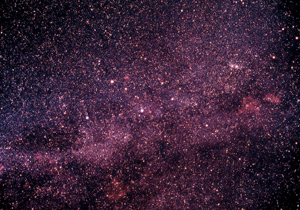 Cassiopeia from Arunah Hill, 2001 This is a stack of 2 film shots of Cassiopeia taken from Arunah Hill. Unfortunately my notes are lacking on the exposure but it is probably a 5 minute (per frame) exposure. Note the mayriad of stars and nebulosity in this image (the famous Double Cluster is visible in the upper right quadrant of the image). Click on the small image and the full size image will open in a new window.
Cassiopeia from Arunah Hill, 2001 This is a stack of 2 film shots of Cassiopeia taken from Arunah Hill. Unfortunately my notes are lacking on the exposure but it is probably a 5 minute (per frame) exposure. Note the mayriad of stars and nebulosity in this image (the famous Double Cluster is visible in the upper right quadrant of the image). Click on the small image and the full size image will open in a new window.
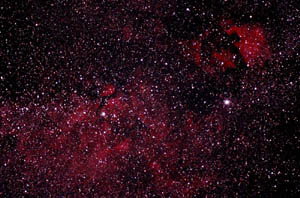 Nebulosity near Deneb and Gamma Cygnus This is a stack of 2 shots taken at CSP11 using a 135mm F2.5 lens. The North American Nebula is easily seen as is parts of the Pelican Nebula. Also there is considerable nebulosity around the bright star Gamma Cygnus. South is the the left on this image, Deneb is the bright star a little below the North American Nebula. Click on the small image and the full size image will open in a new window.
Nebulosity near Deneb and Gamma Cygnus This is a stack of 2 shots taken at CSP11 using a 135mm F2.5 lens. The North American Nebula is easily seen as is parts of the Pelican Nebula. Also there is considerable nebulosity around the bright star Gamma Cygnus. South is the the left on this image, Deneb is the bright star a little below the North American Nebula. Click on the small image and the full size image will open in a new window.
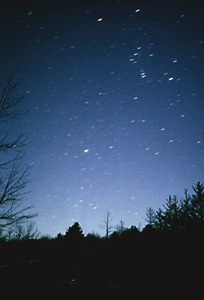 A Moonlit Winter Southern Sky from Voluntown, CT Taken January 2003. Several minute exposure using a 28mm F2.8 wide angle lens with very generic Polaroid 400 speed film (camera was tripod mounted). The sky is lit up blue due to the moon being present on the other side of the sky). Orion is the prominent constellation near the top edge of the photo. Imaged processed in Photoshop 6 December 2003. Click on the small image and the full size image will open in a new window.
A Moonlit Winter Southern Sky from Voluntown, CT Taken January 2003. Several minute exposure using a 28mm F2.8 wide angle lens with very generic Polaroid 400 speed film (camera was tripod mounted). The sky is lit up blue due to the moon being present on the other side of the sky). Orion is the prominent constellation near the top edge of the photo. Imaged processed in Photoshop 6 December 2003. Click on the small image and the full size image will open in a new window.
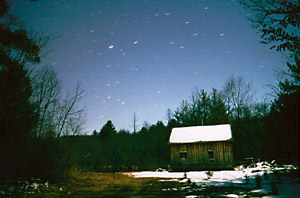 A Moonlit Winter Southern Sky from Voluntown, CT Taken January 2003. Several minute exposure using a 28mm F2.8 wide angle lens with very generic Polaroid 400 speed film (camera was tripod mounted). The sky is lit up blue due to the moon being present on the other side of the sky). This shot shows Canis Major and Lepus. Taken from the south end of my place in Voluntown, CT. Click on the small image and the full size image will open in a new window.
A Moonlit Winter Southern Sky from Voluntown, CT Taken January 2003. Several minute exposure using a 28mm F2.8 wide angle lens with very generic Polaroid 400 speed film (camera was tripod mounted). The sky is lit up blue due to the moon being present on the other side of the sky). This shot shows Canis Major and Lepus. Taken from the south end of my place in Voluntown, CT. Click on the small image and the full size image will open in a new window.
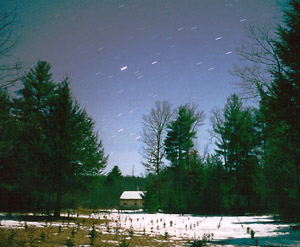 A Moonlit Winter Southern Sky from Voluntown, CT Taken January 2003. Several minute exposure using a 28mm F2.8 wide angle lens with very generic Polaroid 400 speed film (camera was tripod mounted). The sky is lit up blue due to the moon being present on the other side of the sky). A scenic shot of the constellations Canis Major and Lepus rising over a Christmas tree field on the south end of my place in Voluntown, CT. Click on the small image and the full size image will open in a new window.
A Moonlit Winter Southern Sky from Voluntown, CT Taken January 2003. Several minute exposure using a 28mm F2.8 wide angle lens with very generic Polaroid 400 speed film (camera was tripod mounted). The sky is lit up blue due to the moon being present on the other side of the sky). A scenic shot of the constellations Canis Major and Lepus rising over a Christmas tree field on the south end of my place in Voluntown, CT. Click on the small image and the full size image will open in a new window.
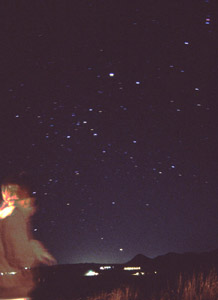 Winter Milky Way from near Palm Springs CA This is an older photo of mine newly redone with a slide scanner. The original was taken on 200 speed slide film around Dec 1985. This is a tripod exposure; Canis Major is easily seen. Note the star Canopus just to the left of the mountain peak (see how much dimmer it is than Sirius due to low altitude). My brother is visible in the expsoure doing the timing. Click on the small image and the full size image will open in a new window.
Winter Milky Way from near Palm Springs CA This is an older photo of mine newly redone with a slide scanner. The original was taken on 200 speed slide film around Dec 1985. This is a tripod exposure; Canis Major is easily seen. Note the star Canopus just to the left of the mountain peak (see how much dimmer it is than Sirius due to low altitude). My brother is visible in the expsoure doing the timing. Click on the small image and the full size image will open in a new window.
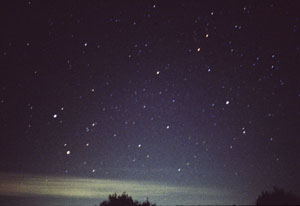 Gemini This is an older photo of mine newly redone with a slide scanner. The original was taken on 200 speed slide film around Dec 1985. The constellation Gemini is seen rising over Norwich CT (as seen from Rt 11 in Salem CT). Light Pollution from Norwich illuminates the low level clouds along the horizon. Click on the small image and the full size image will open in a new window.
Gemini This is an older photo of mine newly redone with a slide scanner. The original was taken on 200 speed slide film around Dec 1985. The constellation Gemini is seen rising over Norwich CT (as seen from Rt 11 in Salem CT). Light Pollution from Norwich illuminates the low level clouds along the horizon. Click on the small image and the full size image will open in a new window.
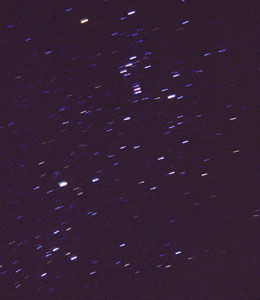 Star Trails from near Mt. Palomar This is an older photo of mine newly redone with a slide scanner. The original was taken on 200 speed slide film around April 1986. I was on business near LA and drove out to Mt. Palomar. The sky out here was VERY dark compared to what I am used to! Looking at the sky, there were so many stars it was hard to pick out some of the constellations! Click on the small image and the full size image will open in a new window.
Star Trails from near Mt. Palomar This is an older photo of mine newly redone with a slide scanner. The original was taken on 200 speed slide film around April 1986. I was on business near LA and drove out to Mt. Palomar. The sky out here was VERY dark compared to what I am used to! Looking at the sky, there were so many stars it was hard to pick out some of the constellations! Click on the small image and the full size image will open in a new window.
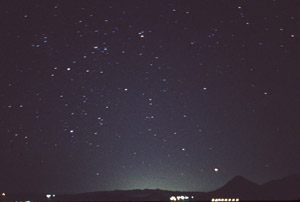 Puppis, Columba and Canopus as seen from near Palm Springs, CA This is an older photo of mine newly redone with a slide scanner. The original was taken on 200 speed slide film around April 1986. I was on business near LA and drove out to the desert area several times. Canopus is the bright star just to the upper left of the mountain peak. This is about as high as Canopus gets as seen from the latitude of Palm Springs CA. Click on the small image and the full size image will open in a new window.
Puppis, Columba and Canopus as seen from near Palm Springs, CA This is an older photo of mine newly redone with a slide scanner. The original was taken on 200 speed slide film around April 1986. I was on business near LA and drove out to the desert area several times. Canopus is the bright star just to the upper left of the mountain peak. This is about as high as Canopus gets as seen from the latitude of Palm Springs CA. Click on the small image and the full size image will open in a new window.
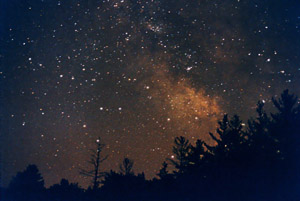 Sample shots from my new home in Voluntown, CT (2002) Voluntown is located in the last remaining sliver of reasonably dark skies that extends from central MA down through eastern CT. Here are some shots from this location. Skies are pretty good here, not perfect, but probably better than 90% of the US population (at least for the moment...). Click on the small image and the page will open in a new window.
Sample shots from my new home in Voluntown, CT (2002) Voluntown is located in the last remaining sliver of reasonably dark skies that extends from central MA down through eastern CT. Here are some shots from this location. Skies are pretty good here, not perfect, but probably better than 90% of the US population (at least for the moment...). Click on the small image and the page will open in a new window.
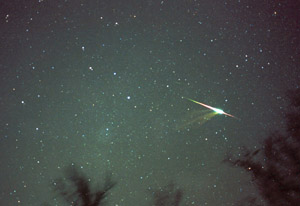 2001 Leonid Meteor Shower My photos of this remarkable and "never forget" event are on this separate page. With full description and notes. Click on the small image and the page will open in a new window.
2001 Leonid Meteor Shower My photos of this remarkable and "never forget" event are on this separate page. With full description and notes. Click on the small image and the page will open in a new window.
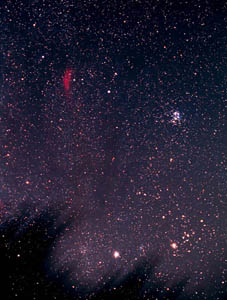 Pleiades, California Nebula, and Hyades from Arunah Hill Taken 22 September 2001 with a 50mm lens at F2.8, two 25 minute stacked exposures on Kodak Royal Gold 400 film. In addition to the objects mentioned, dark vanes are visible in the photo as is Saturn and several open clusters in Taurus. Dark areas near the bottom of the photo are tree branches. Reprocessed 6 December 2003 for improved image. Click on the small image and the full size image will open in a new window.
Pleiades, California Nebula, and Hyades from Arunah Hill Taken 22 September 2001 with a 50mm lens at F2.8, two 25 minute stacked exposures on Kodak Royal Gold 400 film. In addition to the objects mentioned, dark vanes are visible in the photo as is Saturn and several open clusters in Taurus. Dark areas near the bottom of the photo are tree branches. Reprocessed 6 December 2003 for improved image. Click on the small image and the full size image will open in a new window.
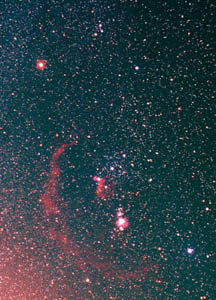 Orion and Barnard's Loop Taken 22 September 2001 from Arunah Hill w/ 50mm lens at F2.8. Three stacked 10 minute exposures. Some red tint is evident at the corner of the image, this is because Orion was not that high up when I took this image. As faint as the Horsehead Nebula area is, Barnard's Loop is even fainter. Film was Kodak Royal Gold 400. Click on the small image and the full size image will open in a new window.
Orion and Barnard's Loop Taken 22 September 2001 from Arunah Hill w/ 50mm lens at F2.8. Three stacked 10 minute exposures. Some red tint is evident at the corner of the image, this is because Orion was not that high up when I took this image. As faint as the Horsehead Nebula area is, Barnard's Loop is even fainter. Film was Kodak Royal Gold 400. Click on the small image and the full size image will open in a new window.
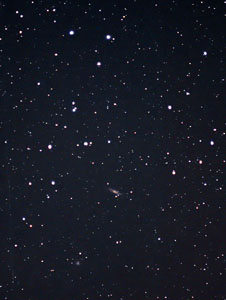 Sculptor, NGC 253, NGC 288 Taken 22 September 2001 from Arunah Hill w/ 135mm lens at F2.8. Single 10 minute exposure. Seen here are stars right below Cetus, along with the famous galaxy NGC 253 and the globular cluster NGC 288 (to the lower left of NGC 253). NGC 288 is very close to the south galactic pole. This photos shows approximately how this area looks through a pair of good binoculars. The southern declination of this region (-25 degrees) makes this area a tough target from +41 deg North! Film was Kodak Royal Gold 400. Click on the small image and the full size image will open in a new window.
Sculptor, NGC 253, NGC 288 Taken 22 September 2001 from Arunah Hill w/ 135mm lens at F2.8. Single 10 minute exposure. Seen here are stars right below Cetus, along with the famous galaxy NGC 253 and the globular cluster NGC 288 (to the lower left of NGC 253). NGC 288 is very close to the south galactic pole. This photos shows approximately how this area looks through a pair of good binoculars. The southern declination of this region (-25 degrees) makes this area a tough target from +41 deg North! Film was Kodak Royal Gold 400. Click on the small image and the full size image will open in a new window.
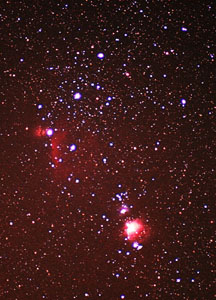 Orion's Belt Area Taken 22 September 2001 from Arunah Hill w/ 135mm lens at F2.8; 10 minute exposure. The outer loop of M42 is visible as is the Horsehead and Flame Nebula complex. Film was Kodak Royal Gold 400. Click on the small image and the full size image will open in a new window.
Orion's Belt Area Taken 22 September 2001 from Arunah Hill w/ 135mm lens at F2.8; 10 minute exposure. The outer loop of M42 is visible as is the Horsehead and Flame Nebula complex. Film was Kodak Royal Gold 400. Click on the small image and the full size image will open in a new window.
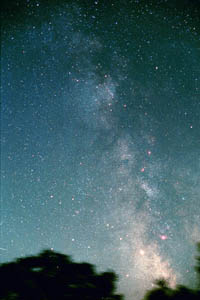 Southern Milky Way from Arunah Hill Taken July 2001 with a 28mm F2.8 lens, about 5 minute exposure. Film was Kodak Royal Gold 400. Click on the small image and the full size image will open in a new window.
Southern Milky Way from Arunah Hill Taken July 2001 with a 28mm F2.8 lens, about 5 minute exposure. Film was Kodak Royal Gold 400. Click on the small image and the full size image will open in a new window.
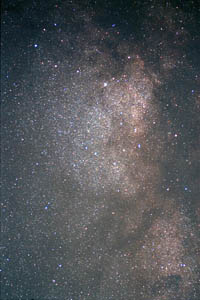 Scutum Star Cloud Taken 14 September 2001 with a 135mm F2.8 lens, about 5 minute exposure. Bright splotch in cloud is cluster M11. Film was Kodak Royal Gold 400. Click on the small image and the full size image will open in a new window.
Scutum Star Cloud Taken 14 September 2001 with a 135mm F2.8 lens, about 5 minute exposure. Bright splotch in cloud is cluster M11. Film was Kodak Royal Gold 400. Click on the small image and the full size image will open in a new window.
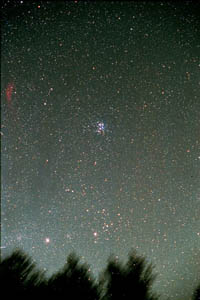 Eastern Sky at CSP 11 Taken 15 September 2001 with a 28mm F2.8 lens, about 5 minute exposure. Pleiades are visible along with several star clusters in Taurus. Also note California Nebula faintly visble along left edge of image! Bright object near Hyades is Saturn. Film was Kodak Royal Gold 400.. Click on the small image and the full size image will open in a new window.
Eastern Sky at CSP 11 Taken 15 September 2001 with a 28mm F2.8 lens, about 5 minute exposure. Pleiades are visible along with several star clusters in Taurus. Also note California Nebula faintly visble along left edge of image! Bright object near Hyades is Saturn. Film was Kodak Royal Gold 400.. Click on the small image and the full size image will open in a new window.
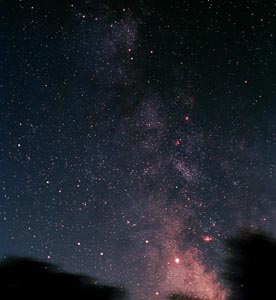 Southern Milky Way from CSP 11 Taken 14 September 2001 with a 135mm F2.8 lens, about 5 minute exposure. Bright object in Milky Way is Mars. Film was Kodak Royal Gold 400. Click on the small image and the full size image will open in a new window.
Southern Milky Way from CSP 11 Taken 14 September 2001 with a 135mm F2.8 lens, about 5 minute exposure. Bright object in Milky Way is Mars. Film was Kodak Royal Gold 400. Click on the small image and the full size image will open in a new window.
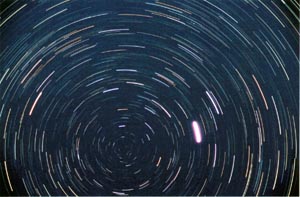 North Star Region taken from Arunah Hill on 15 July 2001 through a Vixen 102ED Refractor with drive off. The bright star is Polaris, it is a lot farther from the true north pole than most people believe! In this photo one can identify a star that is much closer to true north, however it is quite faint. Film was Kodak Royal Gold 400. Click on the small image and the full size image will open in a new window.
North Star Region taken from Arunah Hill on 15 July 2001 through a Vixen 102ED Refractor with drive off. The bright star is Polaris, it is a lot farther from the true north pole than most people believe! In this photo one can identify a star that is much closer to true north, however it is quite faint. Film was Kodak Royal Gold 400. Click on the small image and the full size image will open in a new window.
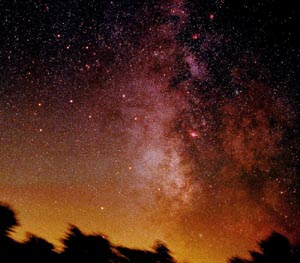 Teapot Area taken from Arunah Hill on 15 July 2001 through a 28mm wide angle lens. Film was Kodak Royal Gold 400. Many Messier objects can be identified in this photo. 5 minute exposure at F2.8. Click on the small image and the full size image will open in a new window.
Teapot Area taken from Arunah Hill on 15 July 2001 through a 28mm wide angle lens. Film was Kodak Royal Gold 400. Many Messier objects can be identified in this photo. 5 minute exposure at F2.8. Click on the small image and the full size image will open in a new window.
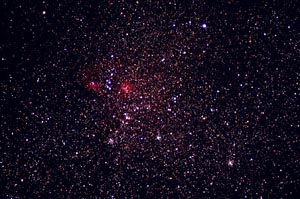 Auriga Milky Way Stacked 10 minute exposures on Kodak Royal Gold 400 film, 135mm F2.8 Canon lens. Photo taken from Randolph, VT (a dark sky site) on 21 October 2000. A number of Messier objects are visible (as is some emission nebulosity). Click on the small image and the page will open in a new window.
Auriga Milky Way Stacked 10 minute exposures on Kodak Royal Gold 400 film, 135mm F2.8 Canon lens. Photo taken from Randolph, VT (a dark sky site) on 21 October 2000. A number of Messier objects are visible (as is some emission nebulosity). Click on the small image and the page will open in a new window.
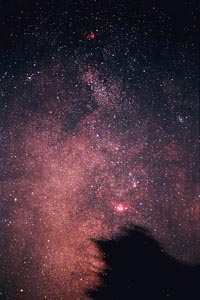 Southern Milky Way Connecticut Star Party 10 Five minute exposure taken with a 28mm lens at F2.8. Photo taken at CSP10 (held at Colebrook CT). A number of Messier objects are visible in this image. Click on the small image and the page will open in a new window.
Southern Milky Way Connecticut Star Party 10 Five minute exposure taken with a 28mm lens at F2.8. Photo taken at CSP10 (held at Colebrook CT). A number of Messier objects are visible in this image. Click on the small image and the page will open in a new window.
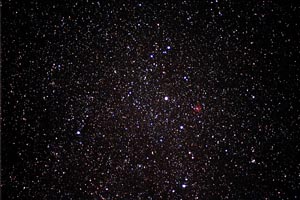 Western Cassiopeia taken with a 135mm lens at F2.5. Composite of three stacked 10 minute exposures on Kodak Royal Gold 400 film. NGC 281 and NGC 7789 visible. Negatives scanned and processed using Photoshop. Taken on 28 Sep 2000 at CSP10, Colbrook, CT. Click on the small image and the page will open in a new window.
Western Cassiopeia taken with a 135mm lens at F2.5. Composite of three stacked 10 minute exposures on Kodak Royal Gold 400 film. NGC 281 and NGC 7789 visible. Negatives scanned and processed using Photoshop. Taken on 28 Sep 2000 at CSP10, Colbrook, CT. Click on the small image and the page will open in a new window.
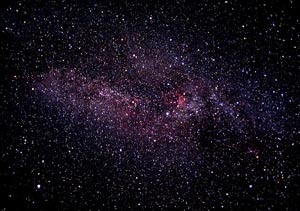 Cygnus Milky Way taken with a 28mm lens at F2.8. Composite of three stacked 10 minute exposures on Kodak Royal Gold 400 film. Negatives scanned and processed using Photoshop. North American Nebula visible along with a number of other deep sky objects. Taken on 28 Sep 2000 at CSP10, Colbrook, CT. Click on the small image and the page will open in a new window.
Cygnus Milky Way taken with a 28mm lens at F2.8. Composite of three stacked 10 minute exposures on Kodak Royal Gold 400 film. Negatives scanned and processed using Photoshop. North American Nebula visible along with a number of other deep sky objects. Taken on 28 Sep 2000 at CSP10, Colbrook, CT. Click on the small image and the page will open in a new window.
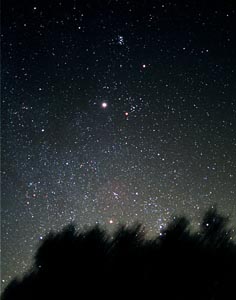 Eastern Sky at CSP10 taken with a 28mm lens at F2.8. Composite of two stacked 10 minute exposures on Kodak Royal Gold 400 film. Jupiter and Saturn are the two prominent "stars". Numerous deep sky objects visible also. Negatives scanned and processed using Photoshop. Taken on 28 Sep 2000 at CSP10, Colbrook, CT. Click on the small image and the page will open in a new window.
Eastern Sky at CSP10 taken with a 28mm lens at F2.8. Composite of two stacked 10 minute exposures on Kodak Royal Gold 400 film. Jupiter and Saturn are the two prominent "stars". Numerous deep sky objects visible also. Negatives scanned and processed using Photoshop. Taken on 28 Sep 2000 at CSP10, Colbrook, CT. Click on the small image and the page will open in a new window.
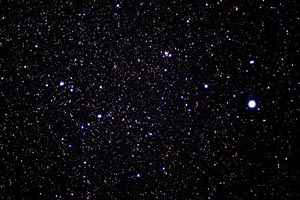 Lyra taken with a 135mm lens at F2.5. Single 10 minute exposure on Kodak Royal Gold 400 film. "Fog" filter used for 2 minutes of the exposure. Negative scanned and processed using Photoshop. Taken on 28 Sep 2000 at CSP10, Colbrook, CT. Click on the small image and the page will open in a new window.
Lyra taken with a 135mm lens at F2.5. Single 10 minute exposure on Kodak Royal Gold 400 film. "Fog" filter used for 2 minutes of the exposure. Negative scanned and processed using Photoshop. Taken on 28 Sep 2000 at CSP10, Colbrook, CT. Click on the small image and the page will open in a new window.
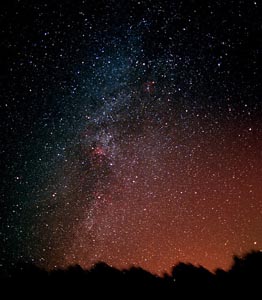 Western Sky at CSP10 taken with a 28mm lens at F2.8. Composite of two stacked 10 minute exposures on Kodak Royal Gold 400 film. Negatives scanned and processed using Photoshop. Taken on 28 Sep 2000 at CSP10, Colbrook, CT. Click on the small image and the page will open in a new window.
Western Sky at CSP10 taken with a 28mm lens at F2.8. Composite of two stacked 10 minute exposures on Kodak Royal Gold 400 film. Negatives scanned and processed using Photoshop. Taken on 28 Sep 2000 at CSP10, Colbrook, CT. Click on the small image and the page will open in a new window.
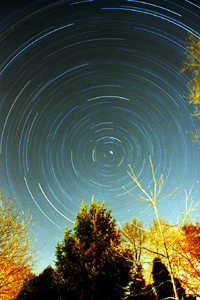 Star Trails A variety of circumpolar (and equatorial) star trial photos from late 1998 (film photos). Click on the small image and the page will open in a new window.
Star Trails A variety of circumpolar (and equatorial) star trial photos from late 1998 (film photos). Click on the small image and the page will open in a new window.
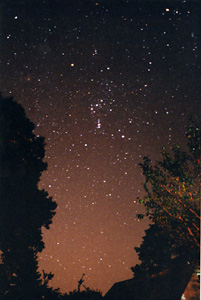 A wide angle shot of the constellations Orion, Lepus and part of Columba Taken with Kodak PMZ-1000 film. 30 second exposure w/ 28mm lens at F2.8. Taken October 1998. Barnard's Nebula faintly visible, Rosette Nebula easily visble (but small). Click on the small image and the full size image will open in a new window.
A wide angle shot of the constellations Orion, Lepus and part of Columba Taken with Kodak PMZ-1000 film. 30 second exposure w/ 28mm lens at F2.8. Taken October 1998. Barnard's Nebula faintly visible, Rosette Nebula easily visble (but small). Click on the small image and the full size image will open in a new window.
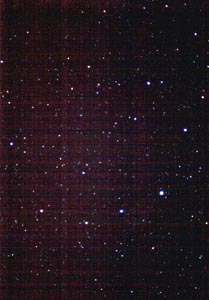 Corona Borealis The Northern Crown, taken 9 March 1997 w/ 135mm F2.5 lens. Click on the small image and the page will open in a new window.
Corona Borealis The Northern Crown, taken 9 March 1997 w/ 135mm F2.5 lens. Click on the small image and the page will open in a new window.
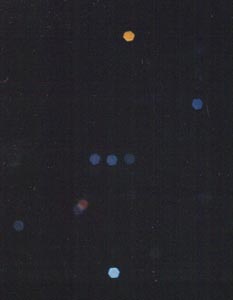 The colors of Orion Stars defocused to bring out colors... Click on the small image and the page will open in a new window.
The colors of Orion Stars defocused to bring out colors... Click on the small image and the page will open in a new window.
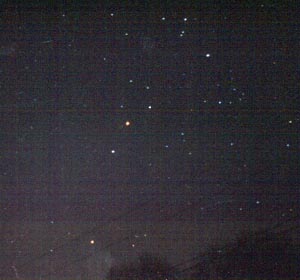 Scorpius struggles to gain altitude from +41 deg north latitude... Click on the small image and the page will open in a new window.
Scorpius struggles to gain altitude from +41 deg north latitude... Click on the small image and the page will open in a new window.
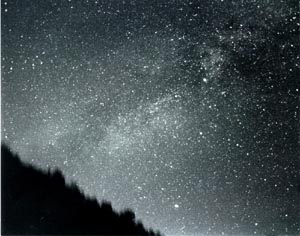 Night sky at CSP IV Too bad my backyard can't be like this... Click on the small image and the page will open in a new window.
Night sky at CSP IV Too bad my backyard can't be like this... Click on the small image and the page will open in a new window.
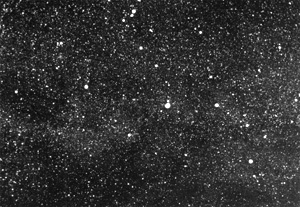 Cassiopeia This is a photo of the constellation Cassiopeia taken from the very dark skies of Vermont, USA. This was taken on 6 August 1994 at Stellafane. A host of deep sky objects are visible in this photo (although some are tough to pick out among the myriad of fainter stars!). The photo was taken with a 50mm F2 Pentax lens stopped to F4, exposure was about 5 minutes. Guiding was piggyback on a Celestron CG-11. Click on the small image and the page will open in a new window.
Cassiopeia This is a photo of the constellation Cassiopeia taken from the very dark skies of Vermont, USA. This was taken on 6 August 1994 at Stellafane. A host of deep sky objects are visible in this photo (although some are tough to pick out among the myriad of fainter stars!). The photo was taken with a 50mm F2 Pentax lens stopped to F4, exposure was about 5 minutes. Guiding was piggyback on a Celestron CG-11. Click on the small image and the page will open in a new window.
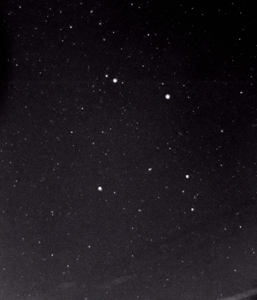 Corvus The "crow", taken from Brimfield, MA. Click on the small image and the page will open in a new window.
Corvus The "crow", taken from Brimfield, MA. Click on the small image and the page will open in a new window.
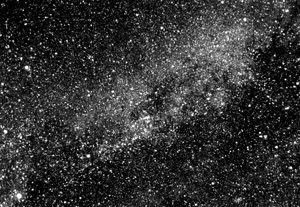 Cygnus Milky Way Here is a photo of the Cygnus Milky Way taken from Vermont (while attending Stellafane, 6 August 1994). Deneb is at the lower left. Photo was taken with a 50mm Pentax F2 lens (stopped to F4) on TMAX 400 film, exposure was about 10 minutes. Guiding was piggyback on a Celestron CG-11. Although it is often cloudy in Vermont, when it is clear it's very dark. Too bad all sites weren't this good... Click on the small image and the page will open in a new window.
Cygnus Milky Way Here is a photo of the Cygnus Milky Way taken from Vermont (while attending Stellafane, 6 August 1994). Deneb is at the lower left. Photo was taken with a 50mm Pentax F2 lens (stopped to F4) on TMAX 400 film, exposure was about 10 minutes. Guiding was piggyback on a Celestron CG-11. Although it is often cloudy in Vermont, when it is clear it's very dark. Too bad all sites weren't this good... Click on the small image and the page will open in a new window.
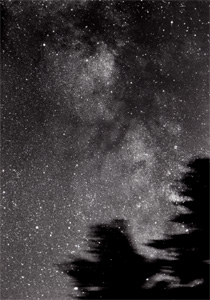 Summer Milky Way from Vermont This is how the summer Milky Way (from the northern hemisphere) looks from a dark sky site. This photo was taken at Stellafane (near Springfield, VT USA) on 6 August 1994. Film was Kodak TMAX 400, lens was a 28mm F2.8, exposure was 15 minutes, guided on a Celestron CG-11 telescope. B+W processing and printing by Joe Roberts. A host of Messier objects can be identified with the help of a star atlas. Note the dark lane structure evident in the Milky Way. If only the sky was like this from my backyard! Click on the small image and the page will open in a new window.
Summer Milky Way from Vermont This is how the summer Milky Way (from the northern hemisphere) looks from a dark sky site. This photo was taken at Stellafane (near Springfield, VT USA) on 6 August 1994. Film was Kodak TMAX 400, lens was a 28mm F2.8, exposure was 15 minutes, guided on a Celestron CG-11 telescope. B+W processing and printing by Joe Roberts. A host of Messier objects can be identified with the help of a star atlas. Note the dark lane structure evident in the Milky Way. If only the sky was like this from my backyard! Click on the small image and the page will open in a new window.
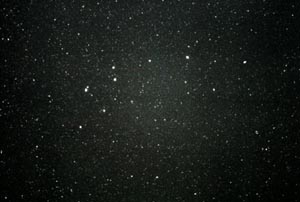 Delphinus A compact constellation. Click on the small image and the page will open in a new window.
Delphinus A compact constellation. Click on the small image and the page will open in a new window.
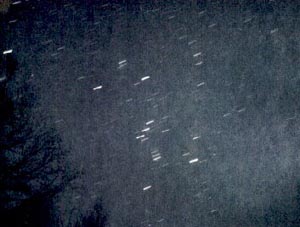 Orion star trails w/ Polaroid My early attempts at astrophotography with a Polaroid camera. Not a great shot by today's standards, but back when I was a kid it was pretty exciting! Click on the small image and the page will open in a new window.
Orion star trails w/ Polaroid My early attempts at astrophotography with a Polaroid camera. Not a great shot by today's standards, but back when I was a kid it was pretty exciting! Click on the small image and the page will open in a new window.
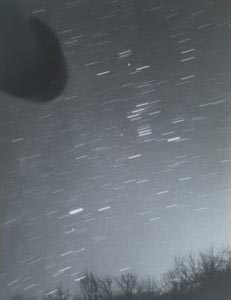 Orion Star Trails Wide angle shot from Wilbraham, MA USA. Another of my early shots using (by today's standards) very crude equipment. Seen at the upper left of the photo is the front of my 2.4 inch Tasco telescope. Click on the small image and the page will open in a new window.
Orion Star Trails Wide angle shot from Wilbraham, MA USA. Another of my early shots using (by today's standards) very crude equipment. Seen at the upper left of the photo is the front of my 2.4 inch Tasco telescope. Click on the small image and the page will open in a new window.
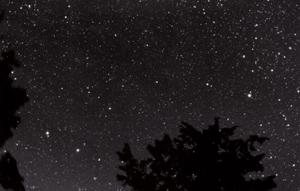 Ursa Minor This is a shot of Ursa Minor taken from Vermont (while attending Stellafane on 6 August 1994). Once again, the pristine skies of Vermont provide an outstanding opportunity to record many faint stars. This shot was taken with a Pentax 50mm F2 lens (stopped to F4) on TMAX 400 film (exposure time not recorded). Developed and processed by me. Click on the small image and the full size image will open in a new window.
Ursa Minor This is a shot of Ursa Minor taken from Vermont (while attending Stellafane on 6 August 1994). Once again, the pristine skies of Vermont provide an outstanding opportunity to record many faint stars. This shot was taken with a Pentax 50mm F2 lens (stopped to F4) on TMAX 400 film (exposure time not recorded). Developed and processed by me. Click on the small image and the full size image will open in a new window.
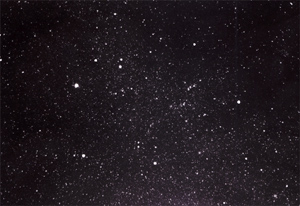 Auriga A film shot of the constellation Auriga. Film was TMAX 400 (exposure time was not recorded). Guiding piggyback on a Celestron CG-11. Taken in 1994. Developed and processed by me. Click on the small image and the full size image will open in a new window.
Auriga A film shot of the constellation Auriga. Film was TMAX 400 (exposure time was not recorded). Guiding piggyback on a Celestron CG-11. Taken in 1994. Developed and processed by me. Click on the small image and the full size image will open in a new window.
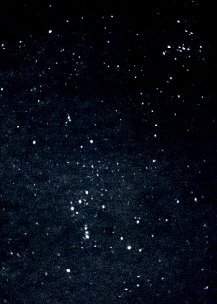 Orion Taken with a Polaroid camera in 1975-1976, one of my earliest astrophotos. Click on the small image and the full size image will open in a new window.
Orion Taken with a Polaroid camera in 1975-1976, one of my earliest astrophotos. Click on the small image and the full size image will open in a new window.
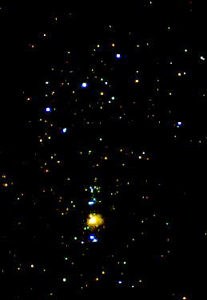 Orion's Belt area Film exposure from 1992. Click on the small image and the full size image will open in a new window.
Orion's Belt area Film exposure from 1992. Click on the small image and the full size image will open in a new window.
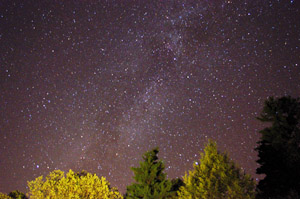 Cygnus This was taken with a Pentax DSLR in the aftermath of hurricane Irene (August 2011). Much of southeastern CT was blacked out resulting in the darkest skies in probably 30 years. Simple tripod time exposure shot. Click on the small image and the full size image will open in a new window.
Cygnus This was taken with a Pentax DSLR in the aftermath of hurricane Irene (August 2011). Much of southeastern CT was blacked out resulting in the darkest skies in probably 30 years. Simple tripod time exposure shot. Click on the small image and the full size image will open in a new window.
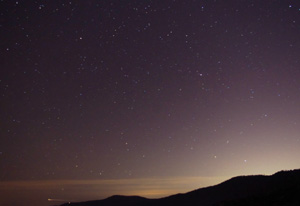 Sculptor This is a DSLR shot of the constellation Sculptor. It was taken from Lake Henshaw in southern California, about 10 miles southeast of Mt. Palomar. The light pollution from greater San Diego is very obvious in this image. Simple tripod shot, 09 Dec2012. Click on the small image and the full size image will open in a new window.
Sculptor This is a DSLR shot of the constellation Sculptor. It was taken from Lake Henshaw in southern California, about 10 miles southeast of Mt. Palomar. The light pollution from greater San Diego is very obvious in this image. Simple tripod shot, 09 Dec2012. Click on the small image and the full size image will open in a new window.
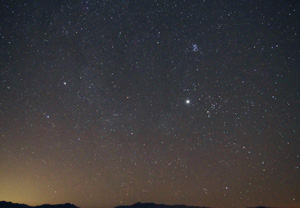 Eastern December Sky This shot (taken from about 10 miles souteast of Mt. Palomar) shows Auriga and Taurus. Easily visible are the Pleiades, Hyades and the bright "star" Jupiter. Simple tripod shot 09 Dec 2012. Click on the small image and the full size image will open in a new window.
Eastern December Sky This shot (taken from about 10 miles souteast of Mt. Palomar) shows Auriga and Taurus. Easily visible are the Pleiades, Hyades and the bright "star" Jupiter. Simple tripod shot 09 Dec 2012. Click on the small image and the full size image will open in a new window.
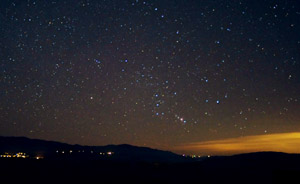 Orion Rising Taken from just above Lake Henshaw in southern CA on 09 Dec 2012, this shot shows Orion just coming up over the horizon. Simple tripod DSLR time exposure (15 seconds). Click on the small image and the full size image will open in a new window.
Orion Rising Taken from just above Lake Henshaw in southern CA on 09 Dec 2012, this shot shows Orion just coming up over the horizon. Simple tripod DSLR time exposure (15 seconds). Click on the small image and the full size image will open in a new window.
 M17 This is a 40 minute (10x240) exposure of the "Swan" nebula in Serpens Cuada, taken on the morning of 05 June 2013. I was only able to get 40 minutes of useful data due to the very short nights (5.5 hours of true darkness) and also de to frames being ruined by satelite trails. The camera was an SBIG STF-8300C, an Astro-Tech field flattener was also in line. Telescope was a Vixen 102ED (102mm F6.5 refractor). The image is reduced in resolution from full resolution of the camera and is cropped. Guiding was via an Orion autoguider through an Orion 900mm F10 refractor. Click on the small image and the full size image will open in a new window. The full resolution version of the image is available here .
M17 This is a 40 minute (10x240) exposure of the "Swan" nebula in Serpens Cuada, taken on the morning of 05 June 2013. I was only able to get 40 minutes of useful data due to the very short nights (5.5 hours of true darkness) and also de to frames being ruined by satelite trails. The camera was an SBIG STF-8300C, an Astro-Tech field flattener was also in line. Telescope was a Vixen 102ED (102mm F6.5 refractor). The image is reduced in resolution from full resolution of the camera and is cropped. Guiding was via an Orion autoguider through an Orion 900mm F10 refractor. Click on the small image and the full size image will open in a new window. The full resolution version of the image is available here .
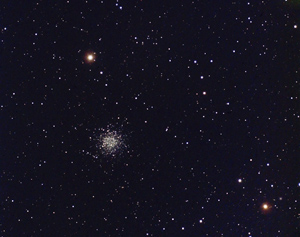 NGC 5466 This is a 168 minute (42x240) exposure of the somewhat obscure globular cluster NGC 5466 in Bootes, taken on 05 June 2013. I used to be able to see this in my 2.4" refractor back in the 70s, but it was pretty dim. The camera was an SBIG STF-8300C, an Astro-Tech field flattener was also in line. Telescope was a Vixen 102ED (102mm F6.5 refractor). The image is at half resolution of the camera and is slightly cropped. Guiding was via an Orion autoguider through an Orion 900mm F10 refractor. Click on the small image and the full size image will open in a new window. The full resolution version of the image is available here .
NGC 5466 This is a 168 minute (42x240) exposure of the somewhat obscure globular cluster NGC 5466 in Bootes, taken on 05 June 2013. I used to be able to see this in my 2.4" refractor back in the 70s, but it was pretty dim. The camera was an SBIG STF-8300C, an Astro-Tech field flattener was also in line. Telescope was a Vixen 102ED (102mm F6.5 refractor). The image is at half resolution of the camera and is slightly cropped. Guiding was via an Orion autoguider through an Orion 900mm F10 refractor. Click on the small image and the full size image will open in a new window. The full resolution version of the image is available here .
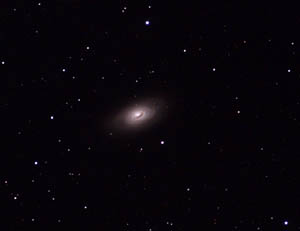 M64 This is a 40 minute (10x240) exposure of the "Blaxk Eye" galaxy (M64) in Coma Berenices, taken on 13 May 2013. The camera was an SBIG STF-8300C, an Astro-Tech field flattener was also in line. Telescope was a Vixen 102ED (102mm F6.5 refractor). The image is at full resolution of the camera and is highly cropped. Guiding was via an SBIG ST-ic autoguider through an Orion 900mm F10 refractor. Conditions were less than great tonight (lots of clouds coming by) so I acquired not nearly as much data as I had hoped to get. Click on the small image and the full size image will open in a new window.
M64 This is a 40 minute (10x240) exposure of the "Blaxk Eye" galaxy (M64) in Coma Berenices, taken on 13 May 2013. The camera was an SBIG STF-8300C, an Astro-Tech field flattener was also in line. Telescope was a Vixen 102ED (102mm F6.5 refractor). The image is at full resolution of the camera and is highly cropped. Guiding was via an SBIG ST-ic autoguider through an Orion 900mm F10 refractor. Conditions were less than great tonight (lots of clouds coming by) so I acquired not nearly as much data as I had hoped to get. Click on the small image and the full size image will open in a new window.
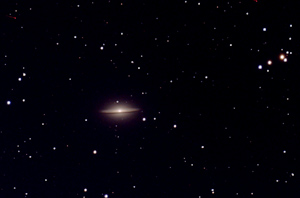 M104 This is a 116 minute (29x240) exposure of the "Sombrero" galaxy (M104) in Virgo, taken on 17 April 2013. The camera was an SBIG STF-8300C, an Astro-Tech field flattener was also in line. Telescope was a Vixen 102ED (102mm F6.5 refractor). The image is at full resolution of the camera and is highly cropped. Guiding was via an Orion autoguider through an Orion 900mm F10 refractor. Click on the small image and the full size image will open in a new window.
M104 This is a 116 minute (29x240) exposure of the "Sombrero" galaxy (M104) in Virgo, taken on 17 April 2013. The camera was an SBIG STF-8300C, an Astro-Tech field flattener was also in line. Telescope was a Vixen 102ED (102mm F6.5 refractor). The image is at full resolution of the camera and is highly cropped. Guiding was via an Orion autoguider through an Orion 900mm F10 refractor. Click on the small image and the full size image will open in a new window.
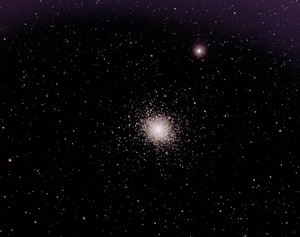 M5 This is a 136 minute (34x240) exposure of globular cluster M5 in Serpens Caput, taken on 17 April 2013. The camera was an SBIG STF-8300C, an Astro-Tech field flattener was also in line. Telescope was a Vixen 102ED (102mm F6.5 refractor). The image is at half resolution of the camera and is slightly cropped. Guiding was via an Orion autoguider through an Orion 900mm F10 refractor. Click on the small image and the full size image will open in a new window. The full resolution version of the image is available here .
M5 This is a 136 minute (34x240) exposure of globular cluster M5 in Serpens Caput, taken on 17 April 2013. The camera was an SBIG STF-8300C, an Astro-Tech field flattener was also in line. Telescope was a Vixen 102ED (102mm F6.5 refractor). The image is at half resolution of the camera and is slightly cropped. Guiding was via an Orion autoguider through an Orion 900mm F10 refractor. Click on the small image and the full size image will open in a new window. The full resolution version of the image is available here .
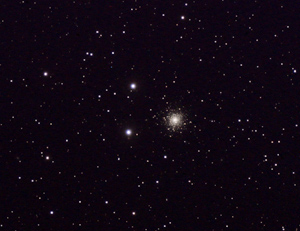 NGC 6229 This is a 100 minute (25x240) exposure of globular cluster NGC 6229 in Hercules, taken on 05 April 2013. The camera was an SBIG STF-8300C, an Astro-Tech field flattener was also in line. Telescope was a Vixen 102ED (102mm F6.5 refractor). This globular was one I used to seek out with my Tasco 2.4" refractor back in the 1970s, it was a fairly difficult object in a scope of that size (even with nice dark skies). The image is at the full resolution of the camera but is highly cropped. Guiding was via an Orion autoguider through an Orion 900mm F10 refractor. Click on the small image and the full size image will open in a new window. The full field version of the image is available here .
NGC 6229 This is a 100 minute (25x240) exposure of globular cluster NGC 6229 in Hercules, taken on 05 April 2013. The camera was an SBIG STF-8300C, an Astro-Tech field flattener was also in line. Telescope was a Vixen 102ED (102mm F6.5 refractor). This globular was one I used to seek out with my Tasco 2.4" refractor back in the 1970s, it was a fairly difficult object in a scope of that size (even with nice dark skies). The image is at the full resolution of the camera but is highly cropped. Guiding was via an Orion autoguider through an Orion 900mm F10 refractor. Click on the small image and the full size image will open in a new window. The full field version of the image is available here .
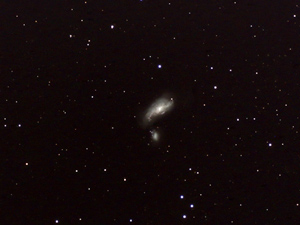 NGC 4490 This is a 196 minute (49x240) exposure of galaxy NGC 4490 in Canes Venatici, taken on 05 April 2013. The camera was an SBIG STF-8300C, an Astro-Tech field flattener was also in line. Telescope was a Vixen 102ED (102mm F6.5 refractor). The image is at the full resolution of the camera but is highly cropped. Guiding was via an Orion autoguider through an Orion 900mm F10 refractor. Click on the small image and the full size image will open in a new window. The full field version of the image is available here .
NGC 4490 This is a 196 minute (49x240) exposure of galaxy NGC 4490 in Canes Venatici, taken on 05 April 2013. The camera was an SBIG STF-8300C, an Astro-Tech field flattener was also in line. Telescope was a Vixen 102ED (102mm F6.5 refractor). The image is at the full resolution of the camera but is highly cropped. Guiding was via an Orion autoguider through an Orion 900mm F10 refractor. Click on the small image and the full size image will open in a new window. The full field version of the image is available here .
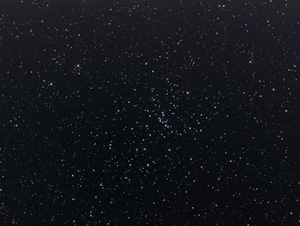 M48 This is a 40 minute (10x240) exposure of cluster M48 in Hydra, taken on 05 April 2013. The camera was an SBIG STF-8300C, an Astro-Tech field flattener was also in line. Telescope was a Vixen 102ED (102mm F6.5 refractor). Guiding was via an Orion autoguider through an Orion 900mm F10 refractor. Click on the small image and the full size image will open in a new window. The full resolution version of the image is available here .
M48 This is a 40 minute (10x240) exposure of cluster M48 in Hydra, taken on 05 April 2013. The camera was an SBIG STF-8300C, an Astro-Tech field flattener was also in line. Telescope was a Vixen 102ED (102mm F6.5 refractor). Guiding was via an Orion autoguider through an Orion 900mm F10 refractor. Click on the small image and the full size image will open in a new window. The full resolution version of the image is available here .
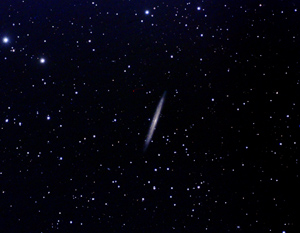 NGC 5907 This is a 260 minute (65x240) exposure of the "Needle" galaxy in Draco, NGC 5907. It was taken on 03 April 2013. The camera was an SBIG STF-8300C, an Astro-Tech field flattener was also in line. Telescope was a Vixen 102ED (102mm F6.5 refractor). The image is at the full resolution of the camera but is cropped somewhat. Guiding was via an Orion autoguider through an Orion 900mm F10 refractor. Click on the small image and the full size image will open in a new window.
NGC 5907 This is a 260 minute (65x240) exposure of the "Needle" galaxy in Draco, NGC 5907. It was taken on 03 April 2013. The camera was an SBIG STF-8300C, an Astro-Tech field flattener was also in line. Telescope was a Vixen 102ED (102mm F6.5 refractor). The image is at the full resolution of the camera but is cropped somewhat. Guiding was via an Orion autoguider through an Orion 900mm F10 refractor. Click on the small image and the full size image will open in a new window.
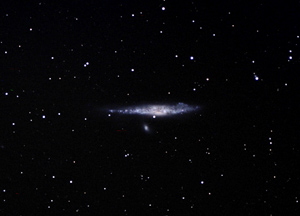 NGC 4631 This is a 136 minute (34x240) exposure of galaxy NGC 4631 in Canes Venatici, taken on 02 April 2013. The camera was an SBIG STF-8300C, an Astro-Tech field flattener was also in line. Telescope was a Vixen 102ED (102mm F6.5 refractor). The image is at the full resolution of the camera but is cropped significantly. Guiding was via an Orion autoguider through an Orion 900mm F10 refractor. Click on the small image and the full size image will open in a new window.
NGC 4631 This is a 136 minute (34x240) exposure of galaxy NGC 4631 in Canes Venatici, taken on 02 April 2013. The camera was an SBIG STF-8300C, an Astro-Tech field flattener was also in line. Telescope was a Vixen 102ED (102mm F6.5 refractor). The image is at the full resolution of the camera but is cropped significantly. Guiding was via an Orion autoguider through an Orion 900mm F10 refractor. Click on the small image and the full size image will open in a new window.
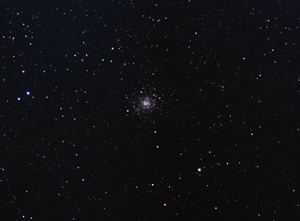 M107 This is a 120 minute (34x240) exposure of globular cluster M107 in Ophiuchus, taken on 02 April 2013. The camera was an SBIG STF-8300C, an Astro-Tech field flattener was also in line. Telescope was a Vixen 102ED (102mm F6.5 refractor). The image is at the full resolution of the camera but is cropped significantly. Guiding was via an Orion autoguider through an Orion 900mm F10 refractor. Click on the small image and the full size image will open in a new window.
M107 This is a 120 minute (34x240) exposure of globular cluster M107 in Ophiuchus, taken on 02 April 2013. The camera was an SBIG STF-8300C, an Astro-Tech field flattener was also in line. Telescope was a Vixen 102ED (102mm F6.5 refractor). The image is at the full resolution of the camera but is cropped significantly. Guiding was via an Orion autoguider through an Orion 900mm F10 refractor. Click on the small image and the full size image will open in a new window.
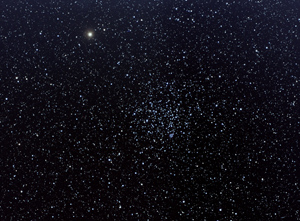 M46and NGC 2438 This is an 80 minute (20x240) exposure of cluster M46 in Puppis, and also planetary nebula NGC 2438 (the small blue donut shaped ring within the cluster). This image was taken on 09 Mar 2013. The camera was an SBIG STF-8300C, an Astro-Tech field flattener was also in line. Telescope was a Vixen 102ED (102mm F6.5 refractor). Guiding was via an Orion autoguider through an Orion 900mm F10 refractor. Click on the small image and the full size image will open in a new window. The full resolution version of the image is available here .
M46and NGC 2438 This is an 80 minute (20x240) exposure of cluster M46 in Puppis, and also planetary nebula NGC 2438 (the small blue donut shaped ring within the cluster). This image was taken on 09 Mar 2013. The camera was an SBIG STF-8300C, an Astro-Tech field flattener was also in line. Telescope was a Vixen 102ED (102mm F6.5 refractor). Guiding was via an Orion autoguider through an Orion 900mm F10 refractor. Click on the small image and the full size image will open in a new window. The full resolution version of the image is available here .
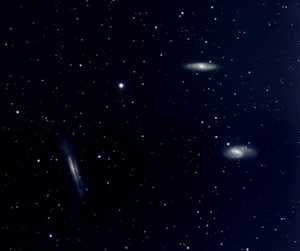 M65, M66 and NGC 3628 This is a 216 minute (54x240) exposure of tria of galaxies in Leo, M65, M66 and NGC 3628. In this image M65 is at the top, M^% at lower right and NGC 3628 at lower left. This image was taken on 09 Mar 2013. The camera was an SBIG STF-8300C, an Astro-Tech field flattener was also in line. Telescope was a Vixen 102ED (102mm F6.5 refractor). The image is reduced in size from full scale of the camera. Guiding was via an Orion autoguider through an Orion 900mm F10 refractor. Click on the small image and the full size image will open in a new window.
M65, M66 and NGC 3628 This is a 216 minute (54x240) exposure of tria of galaxies in Leo, M65, M66 and NGC 3628. In this image M65 is at the top, M^% at lower right and NGC 3628 at lower left. This image was taken on 09 Mar 2013. The camera was an SBIG STF-8300C, an Astro-Tech field flattener was also in line. Telescope was a Vixen 102ED (102mm F6.5 refractor). The image is reduced in size from full scale of the camera. Guiding was via an Orion autoguider through an Orion 900mm F10 refractor. Click on the small image and the full size image will open in a new window.
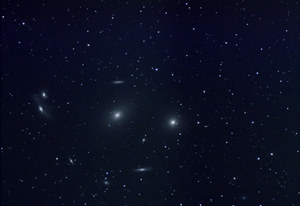 M84 and M86 Region This is a 92 minute (43x240) exposure of M84 - M86 region in Virgo. M84 is the bright round galaxy to the left of center, and M86 is the bright round galaxy to the left of center. Also visible are numerous other galaxies. Ideally this needs more exposure, but time ran out this night. This image was taken on 09 Mar 2013. The camera was an SBIG STF-8300C, an Astro-Tech field flattener was also in line. Telescope was a Vixen 102ED (102mm F6.5 refractor). Guiding was via an Orion autoguider through an Orion 900mm F10 refractor. Click on the small image and the full size image will open in a new window. The full resolution version of the image is available here .
M84 and M86 Region This is a 92 minute (43x240) exposure of M84 - M86 region in Virgo. M84 is the bright round galaxy to the left of center, and M86 is the bright round galaxy to the left of center. Also visible are numerous other galaxies. Ideally this needs more exposure, but time ran out this night. This image was taken on 09 Mar 2013. The camera was an SBIG STF-8300C, an Astro-Tech field flattener was also in line. Telescope was a Vixen 102ED (102mm F6.5 refractor). Guiding was via an Orion autoguider through an Orion 900mm F10 refractor. Click on the small image and the full size image will open in a new window. The full resolution version of the image is available here .
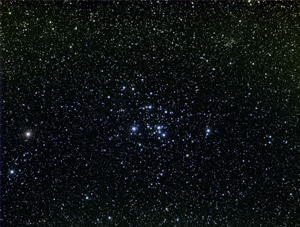 M47and NGC 2423 This is a 92 minute (23x240) exposure of cluster M47 in Puppis, NGC 2423 is the smaller and more condensed cluster above and to the right of M47. This image was taken on 06 Feb 2013. The camera was an SBIG STF-8300C, an Astro-Tech field flattener was also in line and a Baader minus-violet filter. Telescope was a Vixen 102ED (102mm F6.5 refractor). Guiding was via an Orion autoguider through an Orion 900mm F10 refractor. Click on the small image and the full size image will open in a new window. The full resolution version of the image is available here .
M47and NGC 2423 This is a 92 minute (23x240) exposure of cluster M47 in Puppis, NGC 2423 is the smaller and more condensed cluster above and to the right of M47. This image was taken on 06 Feb 2013. The camera was an SBIG STF-8300C, an Astro-Tech field flattener was also in line and a Baader minus-violet filter. Telescope was a Vixen 102ED (102mm F6.5 refractor). Guiding was via an Orion autoguider through an Orion 900mm F10 refractor. Click on the small image and the full size image will open in a new window. The full resolution version of the image is available here .
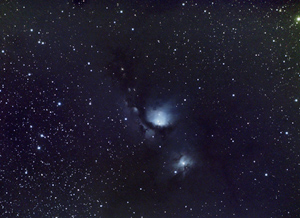 M78 This is a 248 minute (62x240) exposure of M78 in Orion, data for this shot was acquired on the nights of 04 and 06 Feb 2013. The image is cropped soemwhat and reduced in scale from full resolution of the camera. The camera was an SBIG STF-8300C, an Astro-Tech field flattener was also in line and a Baader minus-violet filter. Telescope was a Vixen 102ED (102mm F6.5 refractor). Guiding was via an Orion autoguider through an Orion 900mm F10 refractor. Click on the small image and the full size image will open in a new window.
M78 This is a 248 minute (62x240) exposure of M78 in Orion, data for this shot was acquired on the nights of 04 and 06 Feb 2013. The image is cropped soemwhat and reduced in scale from full resolution of the camera. The camera was an SBIG STF-8300C, an Astro-Tech field flattener was also in line and a Baader minus-violet filter. Telescope was a Vixen 102ED (102mm F6.5 refractor). Guiding was via an Orion autoguider through an Orion 900mm F10 refractor. Click on the small image and the full size image will open in a new window.
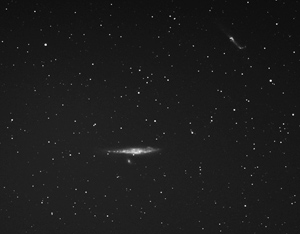 NGC 4631 This is a 224 minute (56x240) monochrome exposure of NGC 4631 in Canes Venatici. Data for this shot was acquired on the overnight of 06 Feb 2013. Just below NGC 4631 is galaxy NGC 4627. To the upper right is NGC 4656. Several other fainter galaxies are also visible upon close inspection. The image is cropped soemwhat but is at full scale resolution of the camera. The camera was an SBIG STF-8300C, an Astro-Tech field flattener was also in line and a Baader minus-violet filter. Telescope was a Vixen 102ED (102mm F6.5 refractor). Guiding was via an Orion autoguider through an Orion 900mm F10 refractor. Click on the small image and the full size image will open in a new window.
NGC 4631 This is a 224 minute (56x240) monochrome exposure of NGC 4631 in Canes Venatici. Data for this shot was acquired on the overnight of 06 Feb 2013. Just below NGC 4631 is galaxy NGC 4627. To the upper right is NGC 4656. Several other fainter galaxies are also visible upon close inspection. The image is cropped soemwhat but is at full scale resolution of the camera. The camera was an SBIG STF-8300C, an Astro-Tech field flattener was also in line and a Baader minus-violet filter. Telescope was a Vixen 102ED (102mm F6.5 refractor). Guiding was via an Orion autoguider through an Orion 900mm F10 refractor. Click on the small image and the full size image will open in a new window.
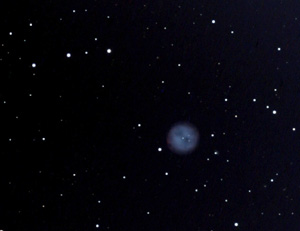 M97, the Owl Nebula This is a 196 minute (49x240) exposure of the Owl Nebula in Ursa Major, taken on 9 Jan 2013. This image is highly cropped (I need to work up a better one but this one will do for now). The camera was an SBIG STF-8300C, an Astro-Tech field flattener was also in line and a Baader minus-violet filter. Telescope was a Vixen 102ED (102mm F6.5 refractor). Guiding was via an Orion autoguider through an Orion 900mm F10 refractor. Click on the small image and the full size image will open in a new window.
M97, the Owl Nebula This is a 196 minute (49x240) exposure of the Owl Nebula in Ursa Major, taken on 9 Jan 2013. This image is highly cropped (I need to work up a better one but this one will do for now). The camera was an SBIG STF-8300C, an Astro-Tech field flattener was also in line and a Baader minus-violet filter. Telescope was a Vixen 102ED (102mm F6.5 refractor). Guiding was via an Orion autoguider through an Orion 900mm F10 refractor. Click on the small image and the full size image will open in a new window.
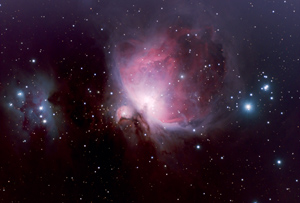 M42, the Orion Nebula This is a 208 minute (52x240) exposure of the Great Nebula in Orion, taken on 9 Jan 2013. The camera was an SBIG STF-8300C, an Astro-Tech field flattener was also in line and a Baader minus-violet filter. Telescope was a Vixen 102ED (102mm F6.5 refractor). Guiding was via an Orion autoguider through an Orion 900mm F10 refractor. Click on the small image and the full size image will open in a new window.
M42, the Orion Nebula This is a 208 minute (52x240) exposure of the Great Nebula in Orion, taken on 9 Jan 2013. The camera was an SBIG STF-8300C, an Astro-Tech field flattener was also in line and a Baader minus-violet filter. Telescope was a Vixen 102ED (102mm F6.5 refractor). Guiding was via an Orion autoguider through an Orion 900mm F10 refractor. Click on the small image and the full size image will open in a new window.
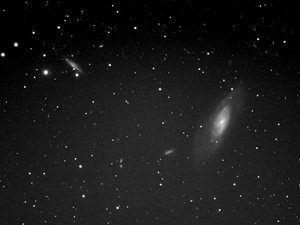 M106 This is a 212 minute (53x240) exposure of galaxy M106 in Canes Venatici, taken on 7 Jan 2013. This image is monochrome for now, the color version needs more work. The edge on galaxy to the upper right of M106 is NGC 4217; the galaxy that looks like a smudge to the lower left of M106 is NGC 4248. Also easily visible are NGC 4231 and NGC 4232. A number of other much fainter galaxies are also detectable .The camera was an SBIG STF-8300C, an Astro-Tech field flattener was also in line and a Baader minus-violet filter. Telescope was a Vixen 102ED (102mm F6.5 refractor). Guiding was via an Orion autoguider through an Orion 900mm F10 refractor. Click on the small image and the full size image will open in a new window.
M106 This is a 212 minute (53x240) exposure of galaxy M106 in Canes Venatici, taken on 7 Jan 2013. This image is monochrome for now, the color version needs more work. The edge on galaxy to the upper right of M106 is NGC 4217; the galaxy that looks like a smudge to the lower left of M106 is NGC 4248. Also easily visible are NGC 4231 and NGC 4232. A number of other much fainter galaxies are also detectable .The camera was an SBIG STF-8300C, an Astro-Tech field flattener was also in line and a Baader minus-violet filter. Telescope was a Vixen 102ED (102mm F6.5 refractor). Guiding was via an Orion autoguider through an Orion 900mm F10 refractor. Click on the small image and the full size image will open in a new window.
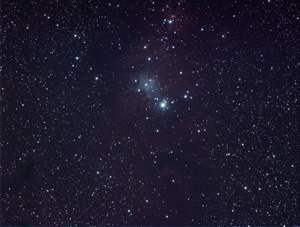 NGC 2264, the Christmas Tree Cluster This is a 212 minute (53x240) exposure of NGC 2264 in Monoceros, taken on 7 Jan 2013. A small portion of the Cone Nebula is visible at the top of the image. The camera was an SBIG STF-8300C, an Astro-Tech field flattener was also in line and a Baader minus-violet filter. Telescope was a Vixen 102ED (102mm F6.5 refractor). Guiding was via an Orion autoguider through an Orion 900mm F10 refractor. Click on the small image and the full size image will open in a new window. The full resolution version of the image is available here .
NGC 2264, the Christmas Tree Cluster This is a 212 minute (53x240) exposure of NGC 2264 in Monoceros, taken on 7 Jan 2013. A small portion of the Cone Nebula is visible at the top of the image. The camera was an SBIG STF-8300C, an Astro-Tech field flattener was also in line and a Baader minus-violet filter. Telescope was a Vixen 102ED (102mm F6.5 refractor). Guiding was via an Orion autoguider through an Orion 900mm F10 refractor. Click on the small image and the full size image will open in a new window. The full resolution version of the image is available here .
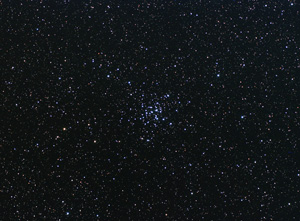 M36 This is a 144 minute (36x240) exposure of cluster M36 in Auriga, taken on 6 Jan 2013. This is one of the 3 major clusters in Auriga. The camera was an SBIG STF-8300C, an Astro-Tech field flattener was also in line and a Baader minus-violet filter. Telescope was a Vixen 102ED (102mm F6.5 refractor). Guiding was via an Orion autoguider through an Orion 900mm F10 refractor. Click on the small image and the full size image will open in a new window. The full resolution version of the image is available here .
M36 This is a 144 minute (36x240) exposure of cluster M36 in Auriga, taken on 6 Jan 2013. This is one of the 3 major clusters in Auriga. The camera was an SBIG STF-8300C, an Astro-Tech field flattener was also in line and a Baader minus-violet filter. Telescope was a Vixen 102ED (102mm F6.5 refractor). Guiding was via an Orion autoguider through an Orion 900mm F10 refractor. Click on the small image and the full size image will open in a new window. The full resolution version of the image is available here .
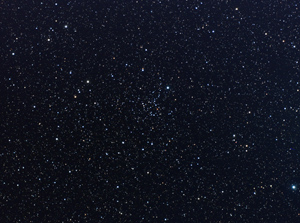 NGC 1664 This is a 188 minute (47x240) exposure of cluster NGC 1664 in Auriga, taken on 6 Jan 2013. The camera was an SBIG STF-8300C, an Astro-Tech field flattener was also in line and a Baader minus-violet filter. Note the very red star in the cluster (almost certainly it is not a member). Telescope was a Vixen 102ED (102mm F6.5 refractor). Guiding was via an Orion autoguider through an Orion 900mm F10 refractor. Click on the small image and the full size image will open in a new window. The full resolution version of the image is available here .
NGC 1664 This is a 188 minute (47x240) exposure of cluster NGC 1664 in Auriga, taken on 6 Jan 2013. The camera was an SBIG STF-8300C, an Astro-Tech field flattener was also in line and a Baader minus-violet filter. Note the very red star in the cluster (almost certainly it is not a member). Telescope was a Vixen 102ED (102mm F6.5 refractor). Guiding was via an Orion autoguider through an Orion 900mm F10 refractor. Click on the small image and the full size image will open in a new window. The full resolution version of the image is available here .
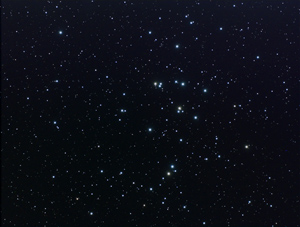 The Beehive Cluster (M44) This is a 140 minute (35x240) exposure of the Beehive cluster in Cancer, taken on 4-5 Jan 2013. The camera was an SBIG STF-8300C, an Astro-Tech field flattener was also in line and a Baader minus-violet filter. Telescope was a Vixen 102ED (102mm F6.5 refractor). Guiding was via an Orion autoguider through an Orion 900mm F10 refractor. A number of faint background galaxies can be seen in the full resolution version (below). Click on the small image and the full size image will open in a new window. The full resolution version of the image is available here .
The Beehive Cluster (M44) This is a 140 minute (35x240) exposure of the Beehive cluster in Cancer, taken on 4-5 Jan 2013. The camera was an SBIG STF-8300C, an Astro-Tech field flattener was also in line and a Baader minus-violet filter. Telescope was a Vixen 102ED (102mm F6.5 refractor). Guiding was via an Orion autoguider through an Orion 900mm F10 refractor. A number of faint background galaxies can be seen in the full resolution version (below). Click on the small image and the full size image will open in a new window. The full resolution version of the image is available here .
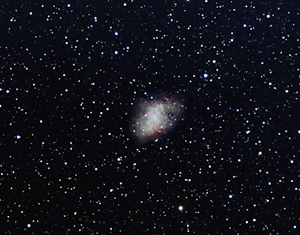 The Crab Nebula (M1) This is a 220 minute (55x240) exposure of the Crab Nebula in Cancer, taken on 4 Jan 2013. The camera was an SBIG STF-8300C, an Astro-Tech field flattener was also in line and a Baader minus-violet filter. Telescope was a Vixen 102ED (102mm F6.5 refractor). Guiding was via an Orion autoguider through an Orion 900mm F10 refractor. This image is at the full resolution of the camera but it is cropped significantly. Click on the small image and the full size image will open in a new window.
The Crab Nebula (M1) This is a 220 minute (55x240) exposure of the Crab Nebula in Cancer, taken on 4 Jan 2013. The camera was an SBIG STF-8300C, an Astro-Tech field flattener was also in line and a Baader minus-violet filter. Telescope was a Vixen 102ED (102mm F6.5 refractor). Guiding was via an Orion autoguider through an Orion 900mm F10 refractor. This image is at the full resolution of the camera but it is cropped significantly. Click on the small image and the full size image will open in a new window.
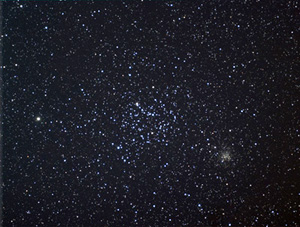 M35 and NGC 2158 Here's a 176 minute (44x240 seconds) exposure of M35 and NGC 2158. This was taken 30 Dec 2012 with a very fat Moon nearby. The camera was an SBIG STF-8300C, an Astro-Tech field flattener was also in line and a Baader minus-violet filter. Telescope was a Vixen 102ED (102mm F6.5 refractor). Guiding was via an Orion autoguider through an Orion 900mm F10 refractor. NGC 2158 is the smaller, denser cluster to the lower right of M35. Click on the small image and the full size image will open in a new window. The full resolution version of the image is available here . I also imaged M35 on 11 October 2012, this image is basically the same equipment as above (without the Minus Violet filter), this one (at the full resolution of the camera) is a 208 minute (52x240) exposure: M35 taken on 11 October 2012 . I took the data from the 11 October image and combined it with the 30 December image to get an image with a total of 6.4 hours of exposure, that image is here: M35, 6.4 hour exposure with data from 11 October and 30 December .
M35 and NGC 2158 Here's a 176 minute (44x240 seconds) exposure of M35 and NGC 2158. This was taken 30 Dec 2012 with a very fat Moon nearby. The camera was an SBIG STF-8300C, an Astro-Tech field flattener was also in line and a Baader minus-violet filter. Telescope was a Vixen 102ED (102mm F6.5 refractor). Guiding was via an Orion autoguider through an Orion 900mm F10 refractor. NGC 2158 is the smaller, denser cluster to the lower right of M35. Click on the small image and the full size image will open in a new window. The full resolution version of the image is available here . I also imaged M35 on 11 October 2012, this image is basically the same equipment as above (without the Minus Violet filter), this one (at the full resolution of the camera) is a 208 minute (52x240) exposure: M35 taken on 11 October 2012 . I took the data from the 11 October image and combined it with the 30 December image to get an image with a total of 6.4 hours of exposure, that image is here: M35, 6.4 hour exposure with data from 11 October and 30 December .
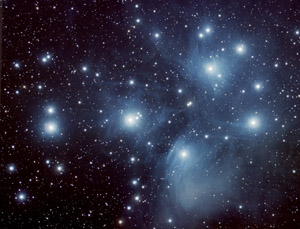 The Pleiades Here is my page about the Pleiades, including my (best as of December 2012) 9 hour 8 minute exposure of this famous cluster. Click on the small image and the full size image will open in a new window.
The Pleiades Here is my page about the Pleiades, including my (best as of December 2012) 9 hour 8 minute exposure of this famous cluster. Click on the small image and the full size image will open in a new window.
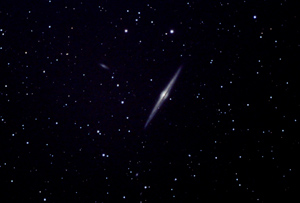 NGC 4565 This is an 80 minute (20x240) exposure of the edge on galaxy NGC 4565 in Coma Berenices, taken on 19 Dec 2012. The image is at the full resolution of the camera but is cropped. The smudge visible to the upper left of the galaxy is 14.5 magnitude NGC 4562. The camera was an SBIG STF-8300C, an Astro-Tech field flattener was also in line and a Baader minus-violet filter. Telescope was a Vixen 102ED (102mm F6.5 refractor). Guiding was via an Orion autoguider through an Orion 900mm F10 refractor. Click on the small image and the full size image will open in a new window.
NGC 4565 This is an 80 minute (20x240) exposure of the edge on galaxy NGC 4565 in Coma Berenices, taken on 19 Dec 2012. The image is at the full resolution of the camera but is cropped. The smudge visible to the upper left of the galaxy is 14.5 magnitude NGC 4562. The camera was an SBIG STF-8300C, an Astro-Tech field flattener was also in line and a Baader minus-violet filter. Telescope was a Vixen 102ED (102mm F6.5 refractor). Guiding was via an Orion autoguider through an Orion 900mm F10 refractor. Click on the small image and the full size image will open in a new window.
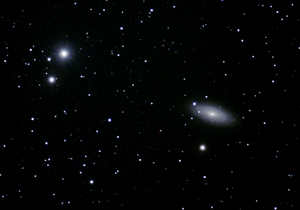 NGC 2841 This is an 208 minute (52x240) exposure of galaxy NGC 2841 in Ursa Major. THis is one of the first non-Messier catalog galaxies that I ever spotted with my Tasco 2.4" refractor back around 1975. This image was taken on 19 Dec 2012. The image is at the full resolution of the camera but it is highly cropped. The camera was an SBIG STF-8300C, an Astro-Tech field flattener was also in line. Telescope was a Vixen 102ED (102mm F6.5 refractor). Guiding was via an Orion autoguider through an Orion 900mm F10 refractor. Click on the small image and the full size image will open in a new window.
NGC 2841 This is an 208 minute (52x240) exposure of galaxy NGC 2841 in Ursa Major. THis is one of the first non-Messier catalog galaxies that I ever spotted with my Tasco 2.4" refractor back around 1975. This image was taken on 19 Dec 2012. The image is at the full resolution of the camera but it is highly cropped. The camera was an SBIG STF-8300C, an Astro-Tech field flattener was also in line. Telescope was a Vixen 102ED (102mm F6.5 refractor). Guiding was via an Orion autoguider through an Orion 900mm F10 refractor. Click on the small image and the full size image will open in a new window.
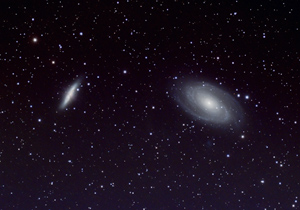 M82 and M81 This is an 592 minute (148x240) exposure of the galaxies M82 (left) and M81 (right). M81's faint companion galaxy (UGC 5336, magnitude 14.3) is visible below M81. Several other fainter galaxies (down to around magnitude 18) are also visible. Data for this image was acquired on 3 nights, 14, 16 and 19 November 2012. The camera was an SBIG STF-8300C, an Astro-Tech field flattener was also in line. Telescope was a Vixen 102ED (102mm F6.5 refractor). Guiding was via an Orion autoguider through an Orion 900mm F10 refractor. Click on the small image and the full size image will open in a new window.
M82 and M81 This is an 592 minute (148x240) exposure of the galaxies M82 (left) and M81 (right). M81's faint companion galaxy (UGC 5336, magnitude 14.3) is visible below M81. Several other fainter galaxies (down to around magnitude 18) are also visible. Data for this image was acquired on 3 nights, 14, 16 and 19 November 2012. The camera was an SBIG STF-8300C, an Astro-Tech field flattener was also in line. Telescope was a Vixen 102ED (102mm F6.5 refractor). Guiding was via an Orion autoguider through an Orion 900mm F10 refractor. Click on the small image and the full size image will open in a new window.
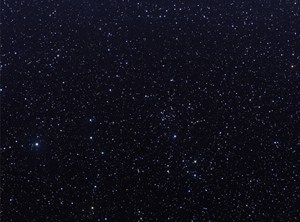 NGC 744 Here's a 92 minute (23x240 seconds) exposure of cluster NGC 744 in Perseus taken on 18 Nov 2012. Also visible (to the upper right of the cluster) is galaxy PGC7676 (magnitude 15.47). A careful inspection also reveals magnitude 17.2 PGC 2493857. To the upper left of the cluster is magnitude 15.6 PGC 2491615. Above the cluster (but small and just detectable) is magnitude 17.2 PGC 2497916. Being able to detect these very faint galaxies with a 4" telescope in moderately light polluted skies is quite satisfying! The camera was an SBIG STF-8300C, an Astro-Tech field flattener was also in line. Telescope was a Vixen 102ED (102mm F6.5 refractor). Guiding was via an Orion autoguider through Celestron C-11. Click on the small image and the full size image will open in a new window. The full resolution version of the image is available here .
NGC 744 Here's a 92 minute (23x240 seconds) exposure of cluster NGC 744 in Perseus taken on 18 Nov 2012. Also visible (to the upper right of the cluster) is galaxy PGC7676 (magnitude 15.47). A careful inspection also reveals magnitude 17.2 PGC 2493857. To the upper left of the cluster is magnitude 15.6 PGC 2491615. Above the cluster (but small and just detectable) is magnitude 17.2 PGC 2497916. Being able to detect these very faint galaxies with a 4" telescope in moderately light polluted skies is quite satisfying! The camera was an SBIG STF-8300C, an Astro-Tech field flattener was also in line. Telescope was a Vixen 102ED (102mm F6.5 refractor). Guiding was via an Orion autoguider through Celestron C-11. Click on the small image and the full size image will open in a new window. The full resolution version of the image is available here .
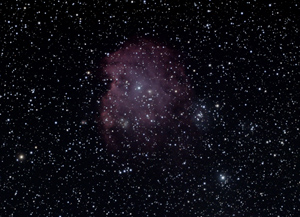 NGC 2174 Here's a 60 minute (15x240 seconds) exposure of nebula NGC 2174 in Orion, taken on 16 Nov 2012. The camera was an SBIG STF-8300C, an Astro-Tech field flattener was also in line. Telescope was a Vixen 102ED (102mm F6.5 refractor). Guiding was via an Orion autoguider through Celestron C-11. Click on the small image and the full size image will open in a new window.
NGC 2174 Here's a 60 minute (15x240 seconds) exposure of nebula NGC 2174 in Orion, taken on 16 Nov 2012. The camera was an SBIG STF-8300C, an Astro-Tech field flattener was also in line. Telescope was a Vixen 102ED (102mm F6.5 refractor). Guiding was via an Orion autoguider through Celestron C-11. Click on the small image and the full size image will open in a new window.
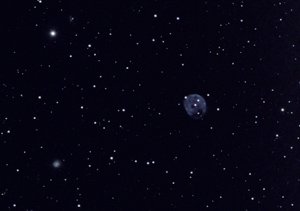 NGC 246 Here's a 56 minute (14x240 seconds) exposure of planetary nebula NGC 246 in Cetus, taken on 16 Nov 2012. This object is pretty low for imaging at my latitude (+41 deg N). It's one of the faintest objects I ever spotted in my 2.4" Tasco refractor (back in the 70s when the sky was very dark). Visible to the lower left of NGC 246 is galaxy NGC 255. The camera was an SBIG STF-8300C, an Astro-Tech field flattener was also in line. Telescope was a Vixen 102ED (102mm F6.5 refractor). Guiding was via an Orion autoguider through Celestron C-11. Click on the small image and the full size image will open in a new window.
NGC 246 Here's a 56 minute (14x240 seconds) exposure of planetary nebula NGC 246 in Cetus, taken on 16 Nov 2012. This object is pretty low for imaging at my latitude (+41 deg N). It's one of the faintest objects I ever spotted in my 2.4" Tasco refractor (back in the 70s when the sky was very dark). Visible to the lower left of NGC 246 is galaxy NGC 255. The camera was an SBIG STF-8300C, an Astro-Tech field flattener was also in line. Telescope was a Vixen 102ED (102mm F6.5 refractor). Guiding was via an Orion autoguider through Celestron C-11. Click on the small image and the full size image will open in a new window.
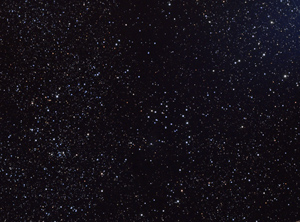 NGC 225 and Stock 24 Here's a 60 minute (15x240 seconds) exposure of clusters NGC 225 (center) and Stock 24 (right) in Cassiopeia taken on 14 Nov 2012. The camera was an SBIG STF-8300C, an Astro-Tech field flattener was also in line. Telescope was a Vixen 102ED (102mm F6.5 refractor). Guiding was via an Orion autoguider through Celestron C-11. Click on the small image and the full size image will open in a new window. The full resolution version of the image is available here .
NGC 225 and Stock 24 Here's a 60 minute (15x240 seconds) exposure of clusters NGC 225 (center) and Stock 24 (right) in Cassiopeia taken on 14 Nov 2012. The camera was an SBIG STF-8300C, an Astro-Tech field flattener was also in line. Telescope was a Vixen 102ED (102mm F6.5 refractor). Guiding was via an Orion autoguider through Celestron C-11. Click on the small image and the full size image will open in a new window. The full resolution version of the image is available here .
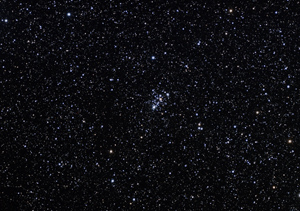 M103 Here's a 132 minute (33x240 seconds) exposure of cluster M103 in Cassiopeia taken on 9 Nov 2012. The camera was an SBIG STF-8300C, an Astro-Tech field flattener was also in line. Telescope was a Vixen 102ED (102mm F6.5 refractor). Guiding was via an Orion autoguider through Celestron C-11. Click on the small image and the full size image will open in a new window. The full resolution version of the image is available here .
M103 Here's a 132 minute (33x240 seconds) exposure of cluster M103 in Cassiopeia taken on 9 Nov 2012. The camera was an SBIG STF-8300C, an Astro-Tech field flattener was also in line. Telescope was a Vixen 102ED (102mm F6.5 refractor). Guiding was via an Orion autoguider through Celestron C-11. Click on the small image and the full size image will open in a new window. The full resolution version of the image is available here .
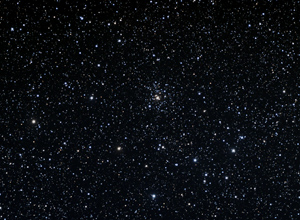 NGC 1857 Here's an 80 minute (20x240 seconds) exposure of cluster NGC 1857 in Auriga, taken on 9 Nov 2012. The camera was an SBIG STF-8300C, an Astro-Tech field flattener was also in line. Telescope was a Vixen 102ED (102mm F6.5 refractor). Guiding was via an Orion autoguider through Celestron C-11. Click on the small image and the full size image will open in a new window. The full resolution version of the image is available here .
NGC 1857 Here's an 80 minute (20x240 seconds) exposure of cluster NGC 1857 in Auriga, taken on 9 Nov 2012. The camera was an SBIG STF-8300C, an Astro-Tech field flattener was also in line. Telescope was a Vixen 102ED (102mm F6.5 refractor). Guiding was via an Orion autoguider through Celestron C-11. Click on the small image and the full size image will open in a new window. The full resolution version of the image is available here .
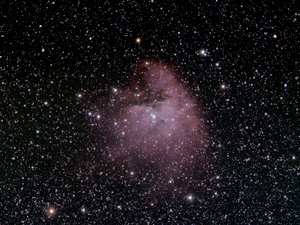 NGC 281 Here's a 7 hour (105x240 seconds) exposure of galactic nebula NGC 281 (the "Pac Man Nebula"). Data was acquired on 4, 5 and 6 November 2012. The camera was an SBIG STF-8300C, an Astro-Tech field flattener was also in line. Telescope was a Vixen 102ED (102mm F6.5 refractor). Guiding was via an Orion autoguider through Celestron C-11. Click on the small image and the full size image will open in a new window.
NGC 281 Here's a 7 hour (105x240 seconds) exposure of galactic nebula NGC 281 (the "Pac Man Nebula"). Data was acquired on 4, 5 and 6 November 2012. The camera was an SBIG STF-8300C, an Astro-Tech field flattener was also in line. Telescope was a Vixen 102ED (102mm F6.5 refractor). Guiding was via an Orion autoguider through Celestron C-11. Click on the small image and the full size image will open in a new window.
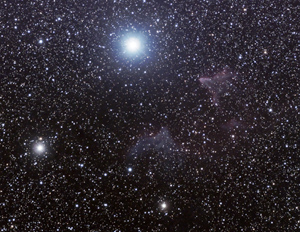 IC 59 and IC 63 Here's a 2 hour (30x240 seconds) exposure of nebulae IC 59 and 63 in Cassiopeia, taken on 21 October 2012. I've been able to see these both visually using a Celestron 11 telescope (in the mid 90s). They were faint but visible. The camera was an SBIG STF-8300C, an Astro-Tech field flattener was also in line. Telescope was a Vixen 102ED (102mm F6.5 refractor). Guiding was via an Orion autoguider through Celestron C-11. Click on the small image and the full size image will open in a new window.
IC 59 and IC 63 Here's a 2 hour (30x240 seconds) exposure of nebulae IC 59 and 63 in Cassiopeia, taken on 21 October 2012. I've been able to see these both visually using a Celestron 11 telescope (in the mid 90s). They were faint but visible. The camera was an SBIG STF-8300C, an Astro-Tech field flattener was also in line. Telescope was a Vixen 102ED (102mm F6.5 refractor). Guiding was via an Orion autoguider through Celestron C-11. Click on the small image and the full size image will open in a new window.
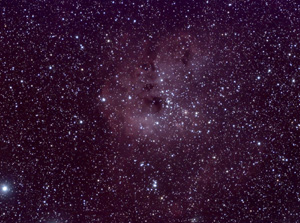 NGC 1893 Here's a 176 minute (44x240 seconds) exposure of NGC 1893, a cluster with nebulosity. It was taken on 21 October 2012. THis object kind of reminds me of a "mini Rosette" nebula. The camera was an SBIG STF-8300C, an Astro-Tech field flattener was also in line. Telescope was a Vixen 102ED (102mm F6.5 refractor). Guiding was via an Orion autoguider through Celestron C-11. Click on the small image and the full size image will open in a new window.
NGC 1893 Here's a 176 minute (44x240 seconds) exposure of NGC 1893, a cluster with nebulosity. It was taken on 21 October 2012. THis object kind of reminds me of a "mini Rosette" nebula. The camera was an SBIG STF-8300C, an Astro-Tech field flattener was also in line. Telescope was a Vixen 102ED (102mm F6.5 refractor). Guiding was via an Orion autoguider through Celestron C-11. Click on the small image and the full size image will open in a new window.
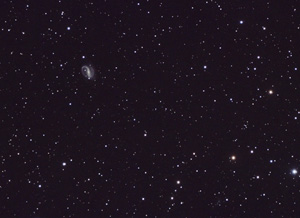 NGC 7479 This is a 140 minute (35x240 seconds) shot of NGC 7479, a barred spiral galaxy in Pegasus. Image taken on 16 October 2012. This is a tough object to image (at this focal length anyway) due to its relatively small angular size. The camera was an SBIG STF-8300C, an Astro-Tech field flattener was also in line. Telescope was a Vixen 102ED (102mm F6.5 refractor). Guiding was via an Orion autoguider through Celestron C-11. Click on the small image and the full size image will open in a new window.
NGC 7479 This is a 140 minute (35x240 seconds) shot of NGC 7479, a barred spiral galaxy in Pegasus. Image taken on 16 October 2012. This is a tough object to image (at this focal length anyway) due to its relatively small angular size. The camera was an SBIG STF-8300C, an Astro-Tech field flattener was also in line. Telescope was a Vixen 102ED (102mm F6.5 refractor). Guiding was via an Orion autoguider through Celestron C-11. Click on the small image and the full size image will open in a new window.
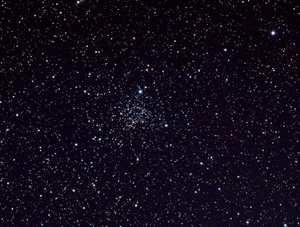 NGC 1245 This is a 212 minute (53x240 seconds) shot of NGC 1245, a rich open cluster in the heart of Perseus. Taken on 16 October 2012. The camera was an SBIG STF-8300C, an Astro-Tech field flattener was also in line. Telescope was a Vixen 102ED (102mm F6.5 refractor). Guiding was via an Orion autoguider through Celestron C-11. Click on the small image and the full size image will open in a new window.
NGC 1245 This is a 212 minute (53x240 seconds) shot of NGC 1245, a rich open cluster in the heart of Perseus. Taken on 16 October 2012. The camera was an SBIG STF-8300C, an Astro-Tech field flattener was also in line. Telescope was a Vixen 102ED (102mm F6.5 refractor). Guiding was via an Orion autoguider through Celestron C-11. Click on the small image and the full size image will open in a new window.
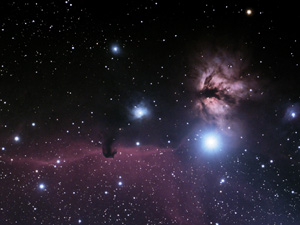 The Flame and HorseHead Nebulae This is a 56 minute (14x240 seconds) shot of Flame and Horsehead Nebula area in Orion. Taken on 16 October 2012. The camera was an SBIG STF-8300C, an Astro-Tech field flattener was also in line. Telescope was a Vixen 102ED (102mm F6.5 refractor). Guiding was via an Orion autoguider through Celestron C-11. Click on the small image and the full size image will open in a new window.
The Flame and HorseHead Nebulae This is a 56 minute (14x240 seconds) shot of Flame and Horsehead Nebula area in Orion. Taken on 16 October 2012. The camera was an SBIG STF-8300C, an Astro-Tech field flattener was also in line. Telescope was a Vixen 102ED (102mm F6.5 refractor). Guiding was via an Orion autoguider through Celestron C-11. Click on the small image and the full size image will open in a new window.
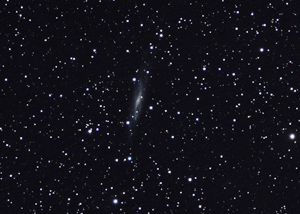 NGC 7640 This is a 168 minute (42x240 seconds) shot of galaxy NGC 7640 in Andromeda. Taken on 14 October 2012 . The camera was an SBIG STF-8300C, an Astro-Tech field flattener was also in line. Telescope was a Vixen 102ED (102mm F6.5 refractor). Guiding was via an Orion autoguider through Celestron C-11. Click on the small image and the full size image will open in a new window.
NGC 7640 This is a 168 minute (42x240 seconds) shot of galaxy NGC 7640 in Andromeda. Taken on 14 October 2012 . The camera was an SBIG STF-8300C, an Astro-Tech field flattener was also in line. Telescope was a Vixen 102ED (102mm F6.5 refractor). Guiding was via an Orion autoguider through Celestron C-11. Click on the small image and the full size image will open in a new window.
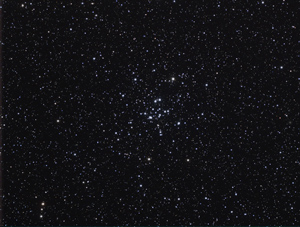 M34 This is a 172 minute (43x240 seconds) exposure of cluster M34 in Perseus, taken on 14 October 2012 2012. This is one of my favorite clusters to image as there are numerous faint background galaxies visible among the stars of the cluster (they are pretty easy to spot in the full resolution version below). The camera was an SBIG STF-8300C, an Astro-Tech field flattener was also in line. Telescope was a Vixen 102ED (102mm F6.5 refractor). Guiding was via an Orion autoguider through Celestron C-11. Click on the small image and the full size image will open in a new window. The full resolution version of the image is available here .
M34 This is a 172 minute (43x240 seconds) exposure of cluster M34 in Perseus, taken on 14 October 2012 2012. This is one of my favorite clusters to image as there are numerous faint background galaxies visible among the stars of the cluster (they are pretty easy to spot in the full resolution version below). The camera was an SBIG STF-8300C, an Astro-Tech field flattener was also in line. Telescope was a Vixen 102ED (102mm F6.5 refractor). Guiding was via an Orion autoguider through Celestron C-11. Click on the small image and the full size image will open in a new window. The full resolution version of the image is available here .
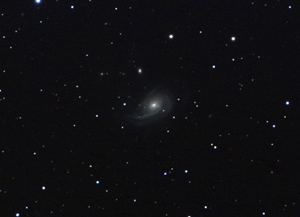 NGC 772 This is a 172 minute (43x240 seconds) exposure of galaxy NGC 772 in Aries, taken on 11 October 2012 . The camera was an SBIG STF-8300C, an Astro-Tech field flattener was also in line. The image is at the full resolution of the camera (the galaxy remains small even at full resolution). Telescope was a Vixen 102ED (102mm F6.5 refractor). Guiding was via an Orion autoguider through Celestron C-11. Click on the small image and the full size image will open in a new window.
NGC 772 This is a 172 minute (43x240 seconds) exposure of galaxy NGC 772 in Aries, taken on 11 October 2012 . The camera was an SBIG STF-8300C, an Astro-Tech field flattener was also in line. The image is at the full resolution of the camera (the galaxy remains small even at full resolution). Telescope was a Vixen 102ED (102mm F6.5 refractor). Guiding was via an Orion autoguider through Celestron C-11. Click on the small image and the full size image will open in a new window.
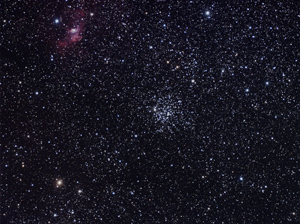 M52 and the Bubble Nebula This is a 152 minute (38x240 seconds) exposure of cluster M52 and the Bubble Nebula (located in Cassiopeia), taken on 11 October 2012 . This image is reduced from full resolution and slightly cropped. The camera was an SBIG STF-8300C, an Astro-Tech field flattener was also in line. Telescope was a Vixen 102ED (102mm F6.5 refractor). Guiding was via an Orion autoguider through Celestron C-11. Click on the small image and the full size image will open in a new window.
M52 and the Bubble Nebula This is a 152 minute (38x240 seconds) exposure of cluster M52 and the Bubble Nebula (located in Cassiopeia), taken on 11 October 2012 . This image is reduced from full resolution and slightly cropped. The camera was an SBIG STF-8300C, an Astro-Tech field flattener was also in line. Telescope was a Vixen 102ED (102mm F6.5 refractor). Guiding was via an Orion autoguider through Celestron C-11. Click on the small image and the full size image will open in a new window.
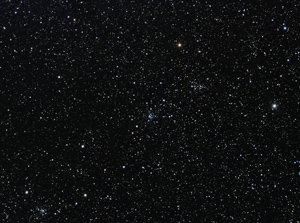 NGC 7788, NGC 7790, Be58, Ha21 and Fr1 This is a 136 minute (34x240 seconds) exposure of cluster rich region of Cassiopeia, taken on 24 September 2012. NGC 7788 is at center, NGC 7790 is to the upper left of 7788. Cluster Harvard 21 is at the lower left of the image. Berkely 58 is at the upper right. The most obscure cluster of this group is Frolov 1, it is below 7788 in this image . The camera was an SBIG STF-8300C, an Astro-Tech field flattener was also in line. Telescope was a Vixen 102ED (102mm F6.5 refractor). Guiding was via an Orion autoguider through Celestron C-11. Click on the small image and the full size image will open in a new window. The full resolution version of the image is available here .
NGC 7788, NGC 7790, Be58, Ha21 and Fr1 This is a 136 minute (34x240 seconds) exposure of cluster rich region of Cassiopeia, taken on 24 September 2012. NGC 7788 is at center, NGC 7790 is to the upper left of 7788. Cluster Harvard 21 is at the lower left of the image. Berkely 58 is at the upper right. The most obscure cluster of this group is Frolov 1, it is below 7788 in this image . The camera was an SBIG STF-8300C, an Astro-Tech field flattener was also in line. Telescope was a Vixen 102ED (102mm F6.5 refractor). Guiding was via an Orion autoguider through Celestron C-11. Click on the small image and the full size image will open in a new window. The full resolution version of the image is available here .
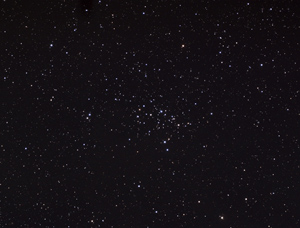 NGC 1342 This is a 140 minute (35x240 seconds) exposure of cluster NGC 1342 in Perseus, taken on 24 September 2012. Also visible are a number of galaxies, includingUGC 2763 (magnitude 15.4), this is the small edge on spiral faintly visible above the cluster. In the far lower left hand corner is UGC 2754 (magnitude 16.2). There are also a number of very faint galaxies that I cannot identify on Sky Safari Pro, so these are likely fainter than 18th magnitude. The camera was an SBIG STF-8300C, an Astro-Tech field flattener was also in line. Telescope was a Vixen 102ED (102mm F6.5 refractor). Guiding was via an Orion autoguider through Celestron C-11. Click on the small image and the full size image will open in a new window. The full resolution version of the image is available here .
NGC 1342 This is a 140 minute (35x240 seconds) exposure of cluster NGC 1342 in Perseus, taken on 24 September 2012. Also visible are a number of galaxies, includingUGC 2763 (magnitude 15.4), this is the small edge on spiral faintly visible above the cluster. In the far lower left hand corner is UGC 2754 (magnitude 16.2). There are also a number of very faint galaxies that I cannot identify on Sky Safari Pro, so these are likely fainter than 18th magnitude. The camera was an SBIG STF-8300C, an Astro-Tech field flattener was also in line. Telescope was a Vixen 102ED (102mm F6.5 refractor). Guiding was via an Orion autoguider through Celestron C-11. Click on the small image and the full size image will open in a new window. The full resolution version of the image is available here .
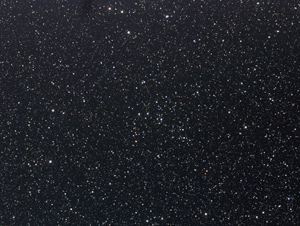 NGC 7243 This is an 80 minute (20x240 seconds) exposure of cluster NGC 7243 in Lacerta, taken on 24 September 2012. The camera was an SBIG STF-8300C, an Astro-Tech field flattener was also in line. Telescope was a Vixen 102ED (102mm F6.5 refractor). Guiding was via an Orion autoguider through Celestron C-11. Click on the small image and the full size image will open in a new window. The full resolution version of the image is available here . In addition, This cropped, enlarged area near NGC 7243 identifies several very faint galaxies located right near the cluster. It's amazing they are visible at all (Lacerta is right in the Milky Way)!
NGC 7243 This is an 80 minute (20x240 seconds) exposure of cluster NGC 7243 in Lacerta, taken on 24 September 2012. The camera was an SBIG STF-8300C, an Astro-Tech field flattener was also in line. Telescope was a Vixen 102ED (102mm F6.5 refractor). Guiding was via an Orion autoguider through Celestron C-11. Click on the small image and the full size image will open in a new window. The full resolution version of the image is available here . In addition, This cropped, enlarged area near NGC 7243 identifies several very faint galaxies located right near the cluster. It's amazing they are visible at all (Lacerta is right in the Milky Way)!
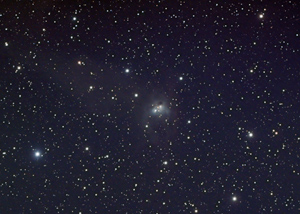 NGC 1788 This is an 88 minute (22x240 seconds) exposure of reflection nebula NGC 1788 in Orion, taken on 24 September 2012. This image is reduced from full resolution and slightly cropped. It really could use more exposure but this is the best I have for now. The camera was an SBIG STF-8300C, an Astro-Tech field flattener was also in line. Telescope was a Vixen 102ED (102mm F6.5 refractor). Guiding was via an Orion autoguider through Celestron C-11. Click on the small image and the full size image will open in a new window.
NGC 1788 This is an 88 minute (22x240 seconds) exposure of reflection nebula NGC 1788 in Orion, taken on 24 September 2012. This image is reduced from full resolution and slightly cropped. It really could use more exposure but this is the best I have for now. The camera was an SBIG STF-8300C, an Astro-Tech field flattener was also in line. Telescope was a Vixen 102ED (102mm F6.5 refractor). Guiding was via an Orion autoguider through Celestron C-11. Click on the small image and the full size image will open in a new window.
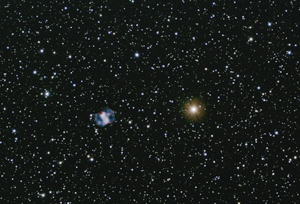 M76 This is a 3 hour (45x240 seconds) exposure of planetary nebula M76 in Perseus, taken on 23 September 2012. Several faint galaxies are visible in the the full resolution wide field version below. The camera was an SBIG STF-8300C, an Astro-Tech field flattener was also in line. Telescope was a Vixen 102ED (102mm F6.5 refractor). Guiding was via an Orion autoguider through Celestron C-11. Click on the small image and the full size image will open in a new window. The full resolution wide field version of the image is available
here . An HD resolution wide field version of the image is available
here .
M76 This is a 3 hour (45x240 seconds) exposure of planetary nebula M76 in Perseus, taken on 23 September 2012. Several faint galaxies are visible in the the full resolution wide field version below. The camera was an SBIG STF-8300C, an Astro-Tech field flattener was also in line. Telescope was a Vixen 102ED (102mm F6.5 refractor). Guiding was via an Orion autoguider through Celestron C-11. Click on the small image and the full size image will open in a new window. The full resolution wide field version of the image is available
here . An HD resolution wide field version of the image is available
here .
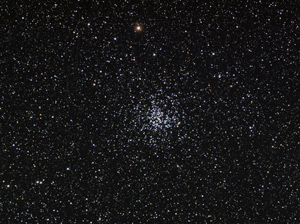 M37 This is a 148 minute (37x240 seconds) exposure of cluster M37 in Auriga, taken on 23 September 2012. This (in my opinion) is the best of the 3 Messier clusters in Auriga. The camera was an SBIG STF-8300C, an Astro-Tech field flattener was also in line. Telescope was a Vixen 102ED (102mm F6.5 refractor). Guiding was via an Orion autoguider through Celestron C-11. Click on the small image and the full size image will open in a new window. The full resolution version of the image is available here .
M37 This is a 148 minute (37x240 seconds) exposure of cluster M37 in Auriga, taken on 23 September 2012. This (in my opinion) is the best of the 3 Messier clusters in Auriga. The camera was an SBIG STF-8300C, an Astro-Tech field flattener was also in line. Telescope was a Vixen 102ED (102mm F6.5 refractor). Guiding was via an Orion autoguider through Celestron C-11. Click on the small image and the full size image will open in a new window. The full resolution version of the image is available here .
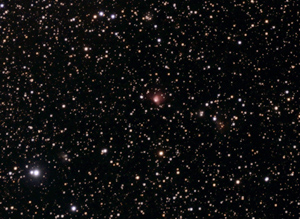 IC 1470 This is a 104 minute (26x240 seconds) exposure of IC 1470 in Cepheus, taken on 23 September 2012. This object really needs more focal length to make the object larger (this image is at the full resolution of the camera but it is cropped highly (see the wide field version below). The camera was an SBIG STF-8300C, an Astro-Tech field flattener was also in line. Telescope was a Vixen 102ED (102mm F6.5 refractor). Guiding was via an Orion autoguider through Celestron C-11. Click on the small image and the full size image will open in a new window. The full resolution version of the image is available here .
IC 1470 This is a 104 minute (26x240 seconds) exposure of IC 1470 in Cepheus, taken on 23 September 2012. This object really needs more focal length to make the object larger (this image is at the full resolution of the camera but it is cropped highly (see the wide field version below). The camera was an SBIG STF-8300C, an Astro-Tech field flattener was also in line. Telescope was a Vixen 102ED (102mm F6.5 refractor). Guiding was via an Orion autoguider through Celestron C-11. Click on the small image and the full size image will open in a new window. The full resolution version of the image is available here .
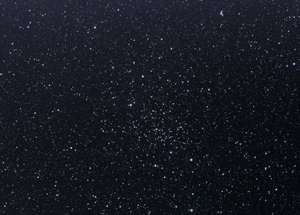 NGC 6940 This is a 72 minute (18x240 seconds) exposure of cluster NGC 6940 in Vulpecula, taken on 21 September 2012. This is a big cluster with fairly faint members, it would be much more obvious if it was not located right in the Milky Way. The camera was an SBIG STF-8300C, an Astro-Tech field flattener was also in line. Telescope was a Vixen 102ED (102mm F6.5 refractor). Guiding was via an Orion autoguider through Celestron C-11. Click on the small image and the full size image will open in a new window. The full resolution version of the image is available here .
NGC 6940 This is a 72 minute (18x240 seconds) exposure of cluster NGC 6940 in Vulpecula, taken on 21 September 2012. This is a big cluster with fairly faint members, it would be much more obvious if it was not located right in the Milky Way. The camera was an SBIG STF-8300C, an Astro-Tech field flattener was also in line. Telescope was a Vixen 102ED (102mm F6.5 refractor). Guiding was via an Orion autoguider through Celestron C-11. Click on the small image and the full size image will open in a new window. The full resolution version of the image is available here .
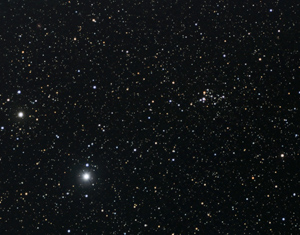 NGC 7235 This is a 52 minute (13x240 seconds) exposure of cluster NGC 7235 in Cepheus, taken on 21 September 2012. This cluster is small; this image is at the full resolution of the camerea but is highly cropped (see wide field versions below). The camera was an SBIG STF-8300C, an Astro-Tech field flattener was also in line. Telescope was a Vixen 102ED (102mm F6.5 refractor). Guiding was via an Orion autoguider through Celestron C-11. Click on the small image and the full size image will open in a new window. The full resolution version of the image is available here . An HD version of the image is available here .
NGC 7235 This is a 52 minute (13x240 seconds) exposure of cluster NGC 7235 in Cepheus, taken on 21 September 2012. This cluster is small; this image is at the full resolution of the camerea but is highly cropped (see wide field versions below). The camera was an SBIG STF-8300C, an Astro-Tech field flattener was also in line. Telescope was a Vixen 102ED (102mm F6.5 refractor). Guiding was via an Orion autoguider through Celestron C-11. Click on the small image and the full size image will open in a new window. The full resolution version of the image is available here . An HD version of the image is available here .
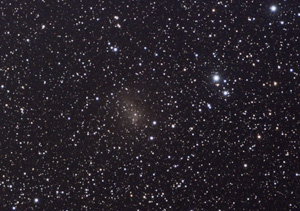 IC 10 This is a 132 minute (33x240 seconds) exposure of galaxy IC 10 in Cassiopeias, taken on 16 September 2012. This galaxy is tough to image as it lies right in the direction of the Milky Way. The image is at the full resolution of the camera but is highly cropped (see full field views below). The camera was an SBIG STF-8300C, an Astro-Tech field flattener was also in line. Telescope was a Vixen 102ED (102mm F6.5 refractor). Guiding was via an Orion autoguider through Celestron C-11. Click on the small image and the full size image will open in a new window. The full resolution version of the image is available here . An HD version of the image is available here .
IC 10 This is a 132 minute (33x240 seconds) exposure of galaxy IC 10 in Cassiopeias, taken on 16 September 2012. This galaxy is tough to image as it lies right in the direction of the Milky Way. The image is at the full resolution of the camera but is highly cropped (see full field views below). The camera was an SBIG STF-8300C, an Astro-Tech field flattener was also in line. Telescope was a Vixen 102ED (102mm F6.5 refractor). Guiding was via an Orion autoguider through Celestron C-11. Click on the small image and the full size image will open in a new window. The full resolution version of the image is available here . An HD version of the image is available here .
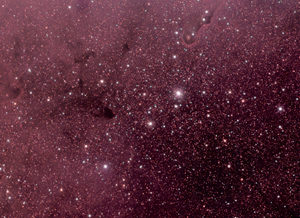 IC 1396 This is a 152 minute (38x240 seconds) exposure of nebula IC 1396 in Cepheus, taken on 16 September 2012. This object is way too big to fit in the field of view so only a prtion of it appears here. The camera was an SBIG STF-8300C, an Astro-Tech field flattener was also in line. Telescope was a Vixen 102ED (102mm F6.5 refractor). Guiding was via an Orion autoguider through Celestron C-11. Click on the small image and the full size image will open in a new window.
IC 1396 This is a 152 minute (38x240 seconds) exposure of nebula IC 1396 in Cepheus, taken on 16 September 2012. This object is way too big to fit in the field of view so only a prtion of it appears here. The camera was an SBIG STF-8300C, an Astro-Tech field flattener was also in line. Telescope was a Vixen 102ED (102mm F6.5 refractor). Guiding was via an Orion autoguider through Celestron C-11. Click on the small image and the full size image will open in a new window.
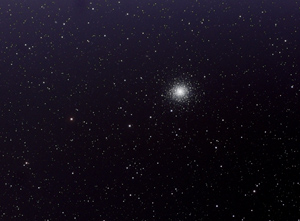 M92 This is a 92 minute (23x240 seconds) exposure of globular cluster M92 in Hercules, taken on 16 September 2012. This globular is often overlooked due to M13 being nearby. Many faint galaxies are visible in the full resolution version below. The camera was an SBIG STF-8300C, an Astro-Tech field flattener was also in line. Telescope was a Vixen 102ED (102mm F6.5 refractor). Guiding was via an Orion autoguider through Celestron C-11. Click on the small image and the full size image will open in a new window. The full resolution version of the image is available here .
M92 This is a 92 minute (23x240 seconds) exposure of globular cluster M92 in Hercules, taken on 16 September 2012. This globular is often overlooked due to M13 being nearby. Many faint galaxies are visible in the full resolution version below. The camera was an SBIG STF-8300C, an Astro-Tech field flattener was also in line. Telescope was a Vixen 102ED (102mm F6.5 refractor). Guiding was via an Orion autoguider through Celestron C-11. Click on the small image and the full size image will open in a new window. The full resolution version of the image is available here .
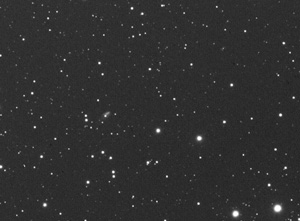 Comet Linear This is a composite of Comet Linear over a 32 minute period on 16 September 2012. The comet appears as a streak as it was moving significantly over the period of time the images were acquired. I also made a movie of the comet see it here ! This is a monochrome image and it is highly cropped. The camera was an SBIG STF-8300C, an Astro-Tech field flattener was also in line. Telescope was a Vixen 102ED (102mm F6.5 refractor). Guiding was via an Orion autoguider through Celestron C-11. Click on the small image and the full size image will open in a new window.
Comet Linear This is a composite of Comet Linear over a 32 minute period on 16 September 2012. The comet appears as a streak as it was moving significantly over the period of time the images were acquired. I also made a movie of the comet see it here ! This is a monochrome image and it is highly cropped. The camera was an SBIG STF-8300C, an Astro-Tech field flattener was also in line. Telescope was a Vixen 102ED (102mm F6.5 refractor). Guiding was via an Orion autoguider through Celestron C-11. Click on the small image and the full size image will open in a new window.
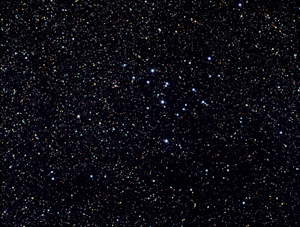 M39 This is a 64 minute exposure (16x240) of M39 in Cygnus, taken on 15 September 2012. The camera was an SBIG STF-8300C, an Astro-Tech field flattener was also in the optical path. Telescope was a Vixen 102ED (102mm F6.5 refractor). Guiding was via an Orion autoguider through Celestron C-11. Click on the small mage and the full size image will open in a new window.
M39 This is a 64 minute exposure (16x240) of M39 in Cygnus, taken on 15 September 2012. The camera was an SBIG STF-8300C, an Astro-Tech field flattener was also in the optical path. Telescope was a Vixen 102ED (102mm F6.5 refractor). Guiding was via an Orion autoguider through Celestron C-11. Click on the small mage and the full size image will open in a new window.
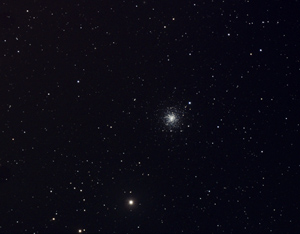 M30 This is a 48 minute exposure (12x240) of M30 in Capricornus, taken on 15 September 2012. THis is a tougher object for me due to its fairly low altitude (from +41 degrees north latitude), plus there is only about a 60 minute "window" to get this due to trees. The camera was an SBIG STF-8300C, an Astro-Tech field flattener was also in the optical path. Telescope was a Vixen 102ED (102mm F6.5 refractor). Guiding was via an Orion autoguider through Celestron C-11. Click on the small mage and the full size image will open in a new window.
M30 This is a 48 minute exposure (12x240) of M30 in Capricornus, taken on 15 September 2012. THis is a tougher object for me due to its fairly low altitude (from +41 degrees north latitude), plus there is only about a 60 minute "window" to get this due to trees. The camera was an SBIG STF-8300C, an Astro-Tech field flattener was also in the optical path. Telescope was a Vixen 102ED (102mm F6.5 refractor). Guiding was via an Orion autoguider through Celestron C-11. Click on the small mage and the full size image will open in a new window.
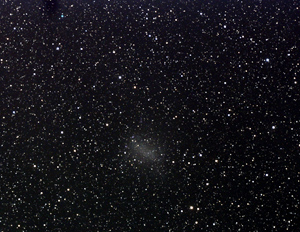 NGC 6822, "Barnard's Galaxy" This is a 60 minute exposure (15x240) of NGC 6822 in Sagittarius, taken on 15 September 2012. Also visble at the upper left of the image (it's small though) is planetary nebula NGC 6818. It shows better in the full resolution version below (it's the blue disk). As a kid I remeber being able to see BOTH of these objects using my Tasco 2.4" refractor, however of course back then skies were FAR darker than they are today. This object is pretty low where I live so I am actually surprised wit how well it came out. You can see some of the nebulae in the galaxy (more easily seen in the full resolution version below). The camera was an SBIG STF-8300C, an Astro-Tech field flattener was also in the optical path. Telescope was a Vixen 102ED (102mm F6.5 refractor). Guiding was via an Orion autoguider through Celestron C-11. Click on the small mage and the full size image will open in a new window. The full resolution version of the image is available here .
NGC 6822, "Barnard's Galaxy" This is a 60 minute exposure (15x240) of NGC 6822 in Sagittarius, taken on 15 September 2012. Also visble at the upper left of the image (it's small though) is planetary nebula NGC 6818. It shows better in the full resolution version below (it's the blue disk). As a kid I remeber being able to see BOTH of these objects using my Tasco 2.4" refractor, however of course back then skies were FAR darker than they are today. This object is pretty low where I live so I am actually surprised wit how well it came out. You can see some of the nebulae in the galaxy (more easily seen in the full resolution version below). The camera was an SBIG STF-8300C, an Astro-Tech field flattener was also in the optical path. Telescope was a Vixen 102ED (102mm F6.5 refractor). Guiding was via an Orion autoguider through Celestron C-11. Click on the small mage and the full size image will open in a new window. The full resolution version of the image is available here .
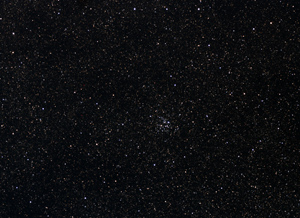 M26 This is a 52 minute exposure (13x240) of star cluster M26 in Scutum, taken on 15 September 2012. Didn't have a lot of time to get this cluster this evening due to trees. The camera was an SBIG STF-8300C, an Astro-Tech field flattener was also in the optical path. Telescope was a Vixen 102ED (102mm F6.5 refractor). Guiding was via an Orion autoguider through Celestron C-11. Click on the small mage and the full size image will open in a new window.
M26 This is a 52 minute exposure (13x240) of star cluster M26 in Scutum, taken on 15 September 2012. Didn't have a lot of time to get this cluster this evening due to trees. The camera was an SBIG STF-8300C, an Astro-Tech field flattener was also in the optical path. Telescope was a Vixen 102ED (102mm F6.5 refractor). Guiding was via an Orion autoguider through Celestron C-11. Click on the small mage and the full size image will open in a new window.
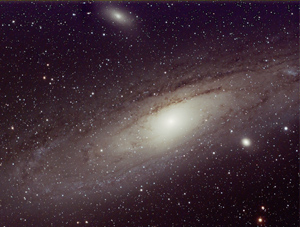 M31 This is a 112 minute exposure (28x240) of M31 in Andromeda, taken 15 September 2012. NGC 205 is of course also easily visible as is M32 (the smaller "blob" that is to the lower right in this image). THis is probably my best image of M31 to date. If you look carefully, a number of faint background galaxies are visible in the background of this image. The camera was an SBIG STF-8300C, an Astro-Tech field flattener was also in the optical path. Telescope was a Vixen 102ED (102mm F6.5 refractor). Guiding was via an Orion autoguider through Celestron C-11. Click on the small mage and the full size image will open in a new window. The full resolution version of the image is available here .
M31 This is a 112 minute exposure (28x240) of M31 in Andromeda, taken 15 September 2012. NGC 205 is of course also easily visible as is M32 (the smaller "blob" that is to the lower right in this image). THis is probably my best image of M31 to date. If you look carefully, a number of faint background galaxies are visible in the background of this image. The camera was an SBIG STF-8300C, an Astro-Tech field flattener was also in the optical path. Telescope was a Vixen 102ED (102mm F6.5 refractor). Guiding was via an Orion autoguider through Celestron C-11. Click on the small mage and the full size image will open in a new window. The full resolution version of the image is available here .
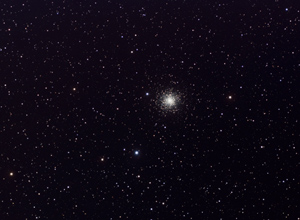 M15 This is a 172 minute exposure (43x240) of globular cluster M15 in Pegasus, taken 13 September 2012. If you look carefully, a number of faint background galaxies are visible in the background of this image. The camera was an SBIG STF-8300C, an Astro-Tech field flattener was also in the optical path. Telescope was a Vixen 102ED (102mm F6.5 refractor). Guiding was via an Orion autoguider through Celestron C-11. Click on the small mage and the full size image will open in a new window. The full resolution version of the image is available here .
M15 This is a 172 minute exposure (43x240) of globular cluster M15 in Pegasus, taken 13 September 2012. If you look carefully, a number of faint background galaxies are visible in the background of this image. The camera was an SBIG STF-8300C, an Astro-Tech field flattener was also in the optical path. Telescope was a Vixen 102ED (102mm F6.5 refractor). Guiding was via an Orion autoguider through Celestron C-11. Click on the small mage and the full size image will open in a new window. The full resolution version of the image is available here .
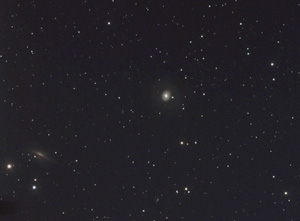 M77 This is a 76 minute exposure (19x240) of galaxy M77 in Cetus, taken 12 September 2012. Also easily visible is galaxy NGC 1055. M77's faint outer halo is visible but faint. The camera was an SBIG STF-8300C, an Astro-Tech field flattener was also in the optical path. Telescope was a Vixen 102ED (102mm F6.5 refractor). Guiding was via an Orion autoguider through Celestron C-11. Click on the small mage and the full size image will open in a new window.
M77 This is a 76 minute exposure (19x240) of galaxy M77 in Cetus, taken 12 September 2012. Also easily visible is galaxy NGC 1055. M77's faint outer halo is visible but faint. The camera was an SBIG STF-8300C, an Astro-Tech field flattener was also in the optical path. Telescope was a Vixen 102ED (102mm F6.5 refractor). Guiding was via an Orion autoguider through Celestron C-11. Click on the small mage and the full size image will open in a new window.
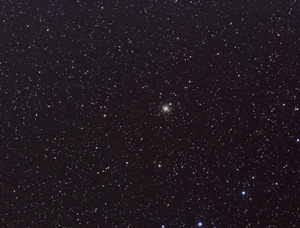 NGC 6934 This is a 192 minute exposure (48x240) of globular cluster NGC 6934 in Delphinus, taken 12 September 2012. This is one of the smaller globulars (compared to many of those in the Messier catalog). Careful insepction of the full resolution image reveals several faint background galaxies. The camera was an SBIG STF-8300C, an Astro-Tech field flattener was also in the optical path. Telescope was a Vixen 102ED (102mm F6.5 refractor). Guiding was via an Orion autoguider through Celestron C-11. Click on the small mage and the full size image will open in a new window. The full resolution version of the image is available here .
NGC 6934 This is a 192 minute exposure (48x240) of globular cluster NGC 6934 in Delphinus, taken 12 September 2012. This is one of the smaller globulars (compared to many of those in the Messier catalog). Careful insepction of the full resolution image reveals several faint background galaxies. The camera was an SBIG STF-8300C, an Astro-Tech field flattener was also in the optical path. Telescope was a Vixen 102ED (102mm F6.5 refractor). Guiding was via an Orion autoguider through Celestron C-11. Click on the small mage and the full size image will open in a new window. The full resolution version of the image is available here .
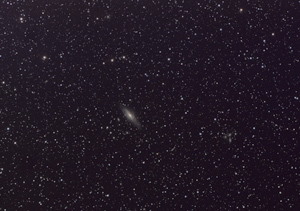 NGC 7331 and Stephan's Quintet This is a 188 minute exposure (47x240) of galaxy NGC 7331 and also Stephan's Quintet, taken 12 September 2012. The full resolution version of the image (below) shows a plethora of faint galaxies. The camera was an SBIG STF-8300C, an Astro-Tech field flattener was also in the optical path. Telescope was a Vixen 102ED (102mm F6.5 refractor). Guiding was via an Orion autoguider through Celestron C-11. Click on the small mage and the full size image will open in a new window. The full resolution version of the image is available here .
NGC 7331 and Stephan's Quintet This is a 188 minute exposure (47x240) of galaxy NGC 7331 and also Stephan's Quintet, taken 12 September 2012. The full resolution version of the image (below) shows a plethora of faint galaxies. The camera was an SBIG STF-8300C, an Astro-Tech field flattener was also in the optical path. Telescope was a Vixen 102ED (102mm F6.5 refractor). Guiding was via an Orion autoguider through Celestron C-11. Click on the small mage and the full size image will open in a new window. The full resolution version of the image is available here .
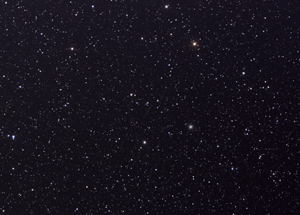 NGC 7006 This is a 68 minute exposure (17x240) of globular cluster NGC 7006 in Delphinus, taken 11 September 2012. This is one of the more obscure globular clusters. The full resolution version of the image (below) shows a good number of faint galaxies. The camera was an SBIG STF-8300C, an Astro-Tech field flattener was also in the optical path. Telescope was a Vixen 102ED (102mm F6.5 refractor). Guiding was via an Orion autoguider through Celestron C-11. Click on the small mage and the full size image will open in a new window. The full resolution version of the image is available here .
NGC 7006 This is a 68 minute exposure (17x240) of globular cluster NGC 7006 in Delphinus, taken 11 September 2012. This is one of the more obscure globular clusters. The full resolution version of the image (below) shows a good number of faint galaxies. The camera was an SBIG STF-8300C, an Astro-Tech field flattener was also in the optical path. Telescope was a Vixen 102ED (102mm F6.5 refractor). Guiding was via an Orion autoguider through Celestron C-11. Click on the small mage and the full size image will open in a new window. The full resolution version of the image is available here .
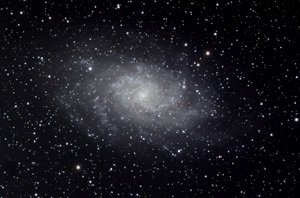 M33 This is a 216 minute exposure (54x240) of the Triangulum Galaxy M33, taken 11 September 2012. A number of objects within the galaxy are visible in this shot. The camera was an SBIG STF-8300C, an Astro-Tech field flattener was also in the optical path. Telescope was a Vixen 102ED (102mm F6.5 refractor). Guiding was via an Orion autoguider through Celestron C-11. Click on the small mage and the full size image will open in a new window.
M33 This is a 216 minute exposure (54x240) of the Triangulum Galaxy M33, taken 11 September 2012. A number of objects within the galaxy are visible in this shot. The camera was an SBIG STF-8300C, an Astro-Tech field flattener was also in the optical path. Telescope was a Vixen 102ED (102mm F6.5 refractor). Guiding was via an Orion autoguider through Celestron C-11. Click on the small mage and the full size image will open in a new window.
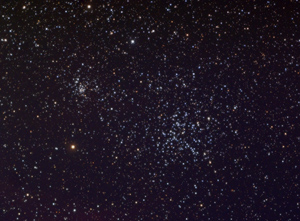 M38 This is a 72 minute exposure (18x240) of the cluster M38 in Auriga, taken 11 September 2012. Also visible is cluster NGC 1907 (the smaller, more compact one). The camera was an SBIG STF-8300C, an Astro-Tech field flattener was also in the optical path. Telescope was a Vixen 102ED (102mm F6.5 refractor). Guiding was via an Orion autoguider through Celestron C-11. Click on the small mage and the full size image will open in a new window.
M38 This is a 72 minute exposure (18x240) of the cluster M38 in Auriga, taken 11 September 2012. Also visible is cluster NGC 1907 (the smaller, more compact one). The camera was an SBIG STF-8300C, an Astro-Tech field flattener was also in the optical path. Telescope was a Vixen 102ED (102mm F6.5 refractor). Guiding was via an Orion autoguider through Celestron C-11. Click on the small mage and the full size image will open in a new window.
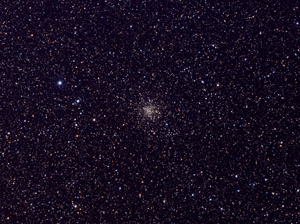 M71 This is a 84 minute exposure (21x240) of
star cluster M71 in Sagitta, taken 10 September 2012. The camera was an SBIG STF-8300C, an Astro-Tech field flattener was also in the optical path. Telescope was a Vixen 102ED (102mm F6.5 refractor). Guiding was via an Orion autoguider through Celestron C-11. Click on the small mage and the full size image will open in a new window.
M71 This is a 84 minute exposure (21x240) of
star cluster M71 in Sagitta, taken 10 September 2012. The camera was an SBIG STF-8300C, an Astro-Tech field flattener was also in the optical path. Telescope was a Vixen 102ED (102mm F6.5 refractor). Guiding was via an Orion autoguider through Celestron C-11. Click on the small mage and the full size image will open in a new window.
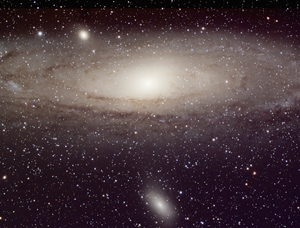 M31 This is a 232 minute exposure (58x240) of M31 in Andromeda, taken 10 September 2012. Framing was not ideal for this shot but still a fair amount of detail is visible. The camera was an SBIG STF-8300C, an Astro-Tech field flattener was also in the optical path. Telescope was a Vixen 102ED (102mm F6.5 refractor). Guiding was via an Orion autoguider through Celestron C-11. Click on the small mage and the full size image will open in a new window. The full resolution version of the image is available here .
M31 This is a 232 minute exposure (58x240) of M31 in Andromeda, taken 10 September 2012. Framing was not ideal for this shot but still a fair amount of detail is visible. The camera was an SBIG STF-8300C, an Astro-Tech field flattener was also in the optical path. Telescope was a Vixen 102ED (102mm F6.5 refractor). Guiding was via an Orion autoguider through Celestron C-11. Click on the small mage and the full size image will open in a new window. The full resolution version of the image is available here .
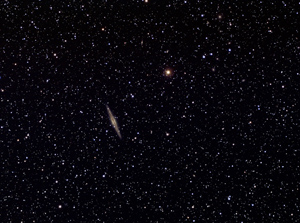 NGC 891 This is a 192 minute exposure (48x240) of edge-on galaxy NGC 891 in Andromeda, taken 9 September 2012. A large number of other background galaxies are visible (especially so in the full resolution version below). The camera was an SBIG STF-8300C, an Astro-Tech field flattener was also in the optical path. Telescope was a Vixen 102ED (102mm F6.5 refractor). Guiding was via an Orion autoguider through Celestron C-11. Click on the small mage and the full size image will open in a new window. The full resolution version of the image is available here .
NGC 891 This is a 192 minute exposure (48x240) of edge-on galaxy NGC 891 in Andromeda, taken 9 September 2012. A large number of other background galaxies are visible (especially so in the full resolution version below). The camera was an SBIG STF-8300C, an Astro-Tech field flattener was also in the optical path. Telescope was a Vixen 102ED (102mm F6.5 refractor). Guiding was via an Orion autoguider through Celestron C-11. Click on the small mage and the full size image will open in a new window. The full resolution version of the image is available here .
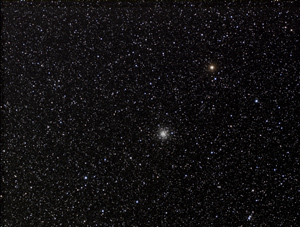 M56 This is a 156 minute exposure (39x240) of globular cluster M56 in Lyra, taken 9 September 2012. The camera was an SBIG STF-8300C, an Astro-Tech field flattener was also in the optical path. Telescope was a Vixen 102ED (102mm F6.5 refractor). Guiding was via an Orion autoguider through Celestron C-11. Click on the small mage and the full size image will open in a new window. The full resolution version of the image is available here .
M56 This is a 156 minute exposure (39x240) of globular cluster M56 in Lyra, taken 9 September 2012. The camera was an SBIG STF-8300C, an Astro-Tech field flattener was also in the optical path. Telescope was a Vixen 102ED (102mm F6.5 refractor). Guiding was via an Orion autoguider through Celestron C-11. Click on the small mage and the full size image will open in a new window. The full resolution version of the image is available here .
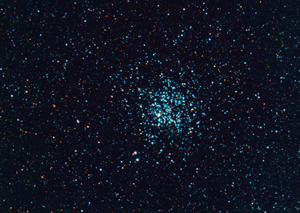 M11 This is a 32 minute exposure (8x240) of star cluster M11 in Scutum, taken 21 July 2012. The image is cropped somewhat and also reduced in scale from the full resolution of the camera. The camera was an Orion StarShoot Pro Deep Space CCD Color Imager (Pro V2 version); a Starizona SCT corrector is in the optical path as is an Orion broadband light pollution filter Telescope was a Celestron 11 (Carbon Fiber Tube modified). Guiding was via an Orion autoguider through a Vixen 102ED refractor. Processed with darks and flats and darks for flats using Maxim DL. Final processing done in Photoshop. Click on the small image and the full size image will open in a new window.
M11 This is a 32 minute exposure (8x240) of star cluster M11 in Scutum, taken 21 July 2012. The image is cropped somewhat and also reduced in scale from the full resolution of the camera. The camera was an Orion StarShoot Pro Deep Space CCD Color Imager (Pro V2 version); a Starizona SCT corrector is in the optical path as is an Orion broadband light pollution filter Telescope was a Celestron 11 (Carbon Fiber Tube modified). Guiding was via an Orion autoguider through a Vixen 102ED refractor. Processed with darks and flats and darks for flats using Maxim DL. Final processing done in Photoshop. Click on the small image and the full size image will open in a new window.
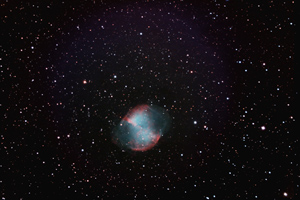 M27 This is a 104 minute exposure (26x240) of planetary nebula M27 in Vulpecula, taken 05 July 2012. The image is cropped somewhat and also reduced in scale from the full resolution of the camera. The camera was an Orion StarShoot Pro Deep Space CCD Color Imager (Pro V2 version); a Starizona SCT corrector is in the optical path as is an Orion broadband light pollution filter Telescope was a Celestron 11 (Carbon Fiber Tube modified). Guiding was via an Orion autoguider through a Vixen 102ED refractor. Processed with darks and flats and darks for flats using Maxim DL. Final processing done in Photoshop. Click on the small mage and the full size image will open in a new window.
M27 This is a 104 minute exposure (26x240) of planetary nebula M27 in Vulpecula, taken 05 July 2012. The image is cropped somewhat and also reduced in scale from the full resolution of the camera. The camera was an Orion StarShoot Pro Deep Space CCD Color Imager (Pro V2 version); a Starizona SCT corrector is in the optical path as is an Orion broadband light pollution filter Telescope was a Celestron 11 (Carbon Fiber Tube modified). Guiding was via an Orion autoguider through a Vixen 102ED refractor. Processed with darks and flats and darks for flats using Maxim DL. Final processing done in Photoshop. Click on the small mage and the full size image will open in a new window.
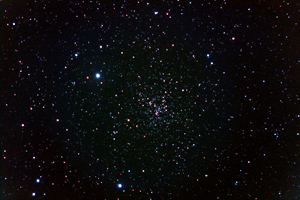 NGC 6819 This is a 24 minute exposure (6x240) of cluster NGC 6819, taken 05 July 2012. The image is cropped slightly. The camera was an Orion StarShoot Pro Deep Space CCD Color Imager (Pro V2 version); a Starizona SCT corrector is in the optical path as is an Orion broadband light pollution filter Telescope was a Celestron 11 (Carbon Fiber Tube modified). Guiding was via an Orion autoguider through a Vixen 102ED refractor. Processed with darks and flats and darks for flats using Maxim DL. Final processing done in Photoshop. Click on the small image and the full size image will open in a new window. The full resolution version of the image is available here .
NGC 6819 This is a 24 minute exposure (6x240) of cluster NGC 6819, taken 05 July 2012. The image is cropped slightly. The camera was an Orion StarShoot Pro Deep Space CCD Color Imager (Pro V2 version); a Starizona SCT corrector is in the optical path as is an Orion broadband light pollution filter Telescope was a Celestron 11 (Carbon Fiber Tube modified). Guiding was via an Orion autoguider through a Vixen 102ED refractor. Processed with darks and flats and darks for flats using Maxim DL. Final processing done in Photoshop. Click on the small image and the full size image will open in a new window. The full resolution version of the image is available here .
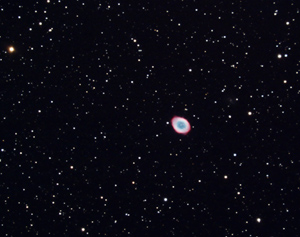 M57 This is a 32 minute exposure (8x240) of the Ring Nebula in Lyra, taken 21 June 2012. The image is cropped somewhat and also reduced in scale from the full resolution of the camera. The camera was an Orion StarShoot Pro Deep Space CCD Color Imager (Pro V2 version); a Starizona SCT corrector is in the optical path as is an Orion broadband light pollution filter Telescope was a Celestron 11 (Carbon Fiber Tube modified). Guiding was via an Orion autoguider through a Vixen 102ED refractor. Processed with darks and flats and darks for flats using Maxim DL. Final processing done in Photoshop. Click on the small mage and the full size image will open in a new window.
M57 This is a 32 minute exposure (8x240) of the Ring Nebula in Lyra, taken 21 June 2012. The image is cropped somewhat and also reduced in scale from the full resolution of the camera. The camera was an Orion StarShoot Pro Deep Space CCD Color Imager (Pro V2 version); a Starizona SCT corrector is in the optical path as is an Orion broadband light pollution filter Telescope was a Celestron 11 (Carbon Fiber Tube modified). Guiding was via an Orion autoguider through a Vixen 102ED refractor. Processed with darks and flats and darks for flats using Maxim DL. Final processing done in Photoshop. Click on the small mage and the full size image will open in a new window.
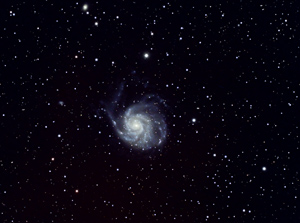 M101 This is a 496 minute exposure (124x240) of the Pinwheel Galaxy (M101) in Ursa Major. Data for this image was acquired on the nights of 18 and 19 May 2012. The camera was an Orion StarShoot Pro Deep Space CCD Color Imager (Pro V2 version), an Astro-Tech field flattener was also in the optical path. Telescope was a Vixen 102ED (102mm F6.5 refractor). Guiding was via an Orion autoguider through Celestron C-11. Click on the small mage and the full size image will open in a new window.
M101 This is a 496 minute exposure (124x240) of the Pinwheel Galaxy (M101) in Ursa Major. Data for this image was acquired on the nights of 18 and 19 May 2012. The camera was an Orion StarShoot Pro Deep Space CCD Color Imager (Pro V2 version), an Astro-Tech field flattener was also in the optical path. Telescope was a Vixen 102ED (102mm F6.5 refractor). Guiding was via an Orion autoguider through Celestron C-11. Click on the small mage and the full size image will open in a new window.
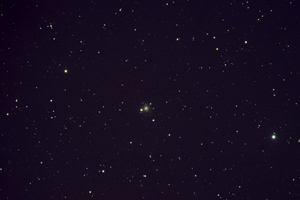 NGC 5634 This is a 128 minute exposure (32x240) of globular cluster NGC 5634 in Virgo, taken 17 May 2012. This image is at the full resolution of the camera but it is significantly cropped (it is really too small of an object to show well with this configuration). The camera was an Orion StarShoot Pro Deep Space CCD Color Imager (version 1), an Astro-Tech field flattener was also in the optical path. Telescope was a Vixen 102ED (102mm F6.5 refractor). Guiding was via an Orion autoguider through Celestron C-11. Click on the small mage and the full size image will open in a new window.
NGC 5634 This is a 128 minute exposure (32x240) of globular cluster NGC 5634 in Virgo, taken 17 May 2012. This image is at the full resolution of the camera but it is significantly cropped (it is really too small of an object to show well with this configuration). The camera was an Orion StarShoot Pro Deep Space CCD Color Imager (version 1), an Astro-Tech field flattener was also in the optical path. Telescope was a Vixen 102ED (102mm F6.5 refractor). Guiding was via an Orion autoguider through Celestron C-11. Click on the small mage and the full size image will open in a new window.
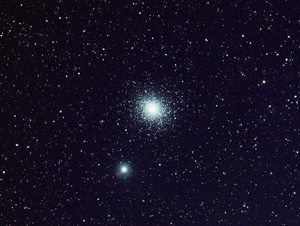 M5 This is a 148 minute exposure (37x240) of globular cluster M5 in Serpens Caput, taken 19 April 2012. The camera was an Orion StarShoot Pro Deep Space CCD Color Imager (version 1), an Astro-Tech field flattener was also in the optical path. Telescope was a Vixen 102ED (102mm F6.5 refractor). Guiding was via an Orion autoguider through Celestron C-11. Click on the small mage and the full size image will open in a new window. The full resolution version of the image is available here .
M5 This is a 148 minute exposure (37x240) of globular cluster M5 in Serpens Caput, taken 19 April 2012. The camera was an Orion StarShoot Pro Deep Space CCD Color Imager (version 1), an Astro-Tech field flattener was also in the optical path. Telescope was a Vixen 102ED (102mm F6.5 refractor). Guiding was via an Orion autoguider through Celestron C-11. Click on the small mage and the full size image will open in a new window. The full resolution version of the image is available here .
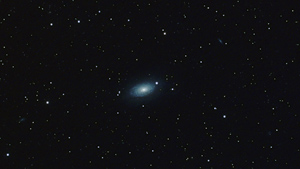 M63 This is a 136 minute exposure (34x240) of galaxy M63 in Canes Venatici, taken 19 April 2012. This image is at the full resolution of the camera but it is significantly cropped. The camera was an Orion StarShoot Pro Deep Space CCD Color Imager (version 1), an Astro-Tech field flattener was also in the optical path. Telescope was a Vixen 102ED (102mm F6.5 refractor). Guiding was via an Orion autoguider through Celestron C-11. Click on the small mage and the full size image will open in a new window.
M63 This is a 136 minute exposure (34x240) of galaxy M63 in Canes Venatici, taken 19 April 2012. This image is at the full resolution of the camera but it is significantly cropped. The camera was an Orion StarShoot Pro Deep Space CCD Color Imager (version 1), an Astro-Tech field flattener was also in the optical path. Telescope was a Vixen 102ED (102mm F6.5 refractor). Guiding was via an Orion autoguider through Celestron C-11. Click on the small mage and the full size image will open in a new window.
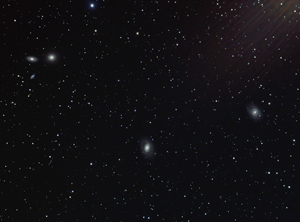 Leo Messier Galaxies This is a 120 minute exposure (30x240) of various galaxies in Leo, taken 27 March 2012. At right is M95; a little below center is M96. In the trio at the upper left, M105 is the right most galaxy. To the left of that is NGC 3384, and the dimmest one of that group is NGC 3389. You may notice a reddish glow at the upper right of the image; this is glare from nearby Mars! The camera was an Orion StarShoot Pro Deep Space CCD Color Imager (version 1), an Astro-Tech field flattener was also in the optical path. Telescope was a Vixen 102ED (102mm F6.5 refractor). Guiding was via an Orion autoguider through Celestron C-11. Click on the small mage and the full size image will open in a new window. The full resolution version of the image is available here .
Leo Messier Galaxies This is a 120 minute exposure (30x240) of various galaxies in Leo, taken 27 March 2012. At right is M95; a little below center is M96. In the trio at the upper left, M105 is the right most galaxy. To the left of that is NGC 3384, and the dimmest one of that group is NGC 3389. You may notice a reddish glow at the upper right of the image; this is glare from nearby Mars! The camera was an Orion StarShoot Pro Deep Space CCD Color Imager (version 1), an Astro-Tech field flattener was also in the optical path. Telescope was a Vixen 102ED (102mm F6.5 refractor). Guiding was via an Orion autoguider through Celestron C-11. Click on the small mage and the full size image will open in a new window. The full resolution version of the image is available here .
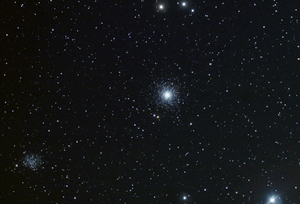 M53 and NGC 5053 This is a 124 minute exposure (31x240) of globular clusters M53 and NGC 5053 in Coma Berenices, taken 22 March 2012. The very bright star at lower right is Alpha Coma Berenices. The camera was an Orion StarShoot Pro Deep Space CCD Color Imager (version 1), an Astro-Tech field flattener was also in the optical path. Telescope was a Vixen 102ED (102mm F6.5 refractor). Guiding was via an Orion autoguider through Celestron C-11. Click on the small mage and the full size image will open in a new window. The full resolution version of the image is available here .
M53 and NGC 5053 This is a 124 minute exposure (31x240) of globular clusters M53 and NGC 5053 in Coma Berenices, taken 22 March 2012. The very bright star at lower right is Alpha Coma Berenices. The camera was an Orion StarShoot Pro Deep Space CCD Color Imager (version 1), an Astro-Tech field flattener was also in the optical path. Telescope was a Vixen 102ED (102mm F6.5 refractor). Guiding was via an Orion autoguider through Celestron C-11. Click on the small mage and the full size image will open in a new window. The full resolution version of the image is available here .
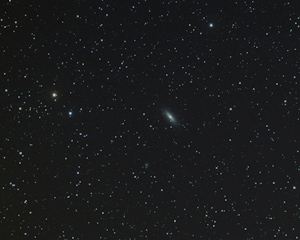 NGC 3115 This is a 176 minute exposure (44x240) of the so called "spindle" galaxy, NGC 3115 in Sextans, taken 22 March 2012. The image is at the full resolution of the camera but is cropped somewhat. Several other galaxies are also visible in this image. The camera was an Orion StarShoot Pro Deep Space CCD Color Imager (version 1), an Astro-Tech field flattener was also in the optical path. Telescope was a Vixen 102ED (102mm F6.5 refractor). Guiding was via an Orion autoguider through Celestron C-11. Click on the small mage and the full size image will open in a new window.
NGC 3115 This is a 176 minute exposure (44x240) of the so called "spindle" galaxy, NGC 3115 in Sextans, taken 22 March 2012. The image is at the full resolution of the camera but is cropped somewhat. Several other galaxies are also visible in this image. The camera was an Orion StarShoot Pro Deep Space CCD Color Imager (version 1), an Astro-Tech field flattener was also in the optical path. Telescope was a Vixen 102ED (102mm F6.5 refractor). Guiding was via an Orion autoguider through Celestron C-11. Click on the small mage and the full size image will open in a new window.
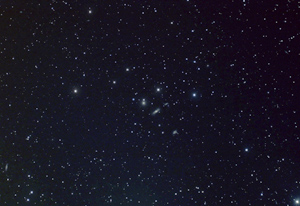 NGC 3190 Group This is a 140 minute exposure (35x240) of the NGC 3190 galaxy group in Leo, taken 21 March 2012. NGC 3190 is the bright elongated galaxy (with the dark lane) near the center of the group. Above and to the left is galaxy NGC 3193; to the lower right is NGC 3185. The dimmer galaxy to the upper right of 3190 is NGC 3187. At the lower left of the image is NGC 3221. The camera was an Orion StarShoot Pro Deep Space CCD Color Imager (version 1), an Astro-Tech field flattener was also in the optical path. Telescope was a Vixen 102ED (102mm F6.5 refractor). Guiding was via an Orion autoguider through Celestron C-11. Click on the small mage and the full size image will open in a new window. The full resolution version of the image is available here .
NGC 3190 Group This is a 140 minute exposure (35x240) of the NGC 3190 galaxy group in Leo, taken 21 March 2012. NGC 3190 is the bright elongated galaxy (with the dark lane) near the center of the group. Above and to the left is galaxy NGC 3193; to the lower right is NGC 3185. The dimmer galaxy to the upper right of 3190 is NGC 3187. At the lower left of the image is NGC 3221. The camera was an Orion StarShoot Pro Deep Space CCD Color Imager (version 1), an Astro-Tech field flattener was also in the optical path. Telescope was a Vixen 102ED (102mm F6.5 refractor). Guiding was via an Orion autoguider through Celestron C-11. Click on the small mage and the full size image will open in a new window. The full resolution version of the image is available here .
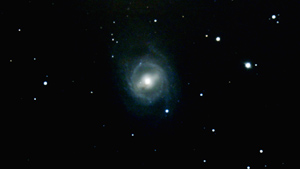 M95 and Supernova This is a 56 minute exposure (14x240) of the galaxy M95 in Leo, taken 18 March 2012 (it needs more exposure). I just happened to (unknowingly) image the M95 supernova (see it marked in the image below). The camera was an Orion StarShoot Pro Deep Space CCD Color Imager (version 1), the telescope was a Celestron 14 (with an F6.3 reducer installed). Guiding was via an Orion autoguider through a Vixen 102ED refractor. Click on the small mage and the full size image will open in a new window. The image with the supernova marked is available here .
M95 and Supernova This is a 56 minute exposure (14x240) of the galaxy M95 in Leo, taken 18 March 2012 (it needs more exposure). I just happened to (unknowingly) image the M95 supernova (see it marked in the image below). The camera was an Orion StarShoot Pro Deep Space CCD Color Imager (version 1), the telescope was a Celestron 14 (with an F6.3 reducer installed). Guiding was via an Orion autoguider through a Vixen 102ED refractor. Click on the small mage and the full size image will open in a new window. The image with the supernova marked is available here .
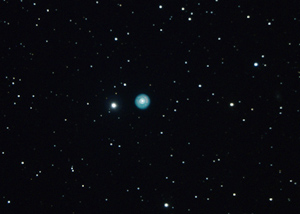 Eskimo Nebula, NGC 2392 This is a 40 minute exposure (10x240) of the planetary nebula NGC 2392 in Gemini, taken 18 March 2012. The image is at the full resolution of the camera but is cropped considerably. The camera was an Orion StarShoot Pro Deep Space CCD Color Imager (version 1), the telescope was a Celestron 14 (with an F6.3 reducer installed). Guiding was via an Orion autoguider through a Vixen 102ED refractor. Click on the small mage and the full size image will open in a new window.
Eskimo Nebula, NGC 2392 This is a 40 minute exposure (10x240) of the planetary nebula NGC 2392 in Gemini, taken 18 March 2012. The image is at the full resolution of the camera but is cropped considerably. The camera was an Orion StarShoot Pro Deep Space CCD Color Imager (version 1), the telescope was a Celestron 14 (with an F6.3 reducer installed). Guiding was via an Orion autoguider through a Vixen 102ED refractor. Click on the small mage and the full size image will open in a new window.
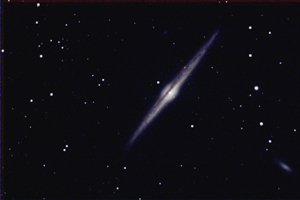 NGC 4565 This is a 72 minute exposure (18x240) of the edge on galaxy NGC 4565 in Coma Berenices, taken 18 March 2012. The image is at the half scale resolution of the camera but is cropped considerably. The camera was an Orion StarShoot Pro Deep Space CCD Color Imager (version 1), the telescope was a Celestron 14 (with an F6.3 reducer installed). Guiding was via an Orion autoguider through a Vixen 102ED refractor. Click on the small mage and the full size image will open in a new window.
NGC 4565 This is a 72 minute exposure (18x240) of the edge on galaxy NGC 4565 in Coma Berenices, taken 18 March 2012. The image is at the half scale resolution of the camera but is cropped considerably. The camera was an Orion StarShoot Pro Deep Space CCD Color Imager (version 1), the telescope was a Celestron 14 (with an F6.3 reducer installed). Guiding was via an Orion autoguider through a Vixen 102ED refractor. Click on the small mage and the full size image will open in a new window.
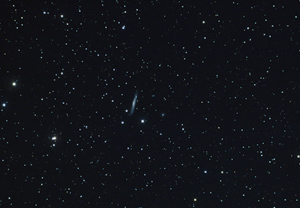 NGC 3079 This is a 208 minute exposure (52x240) of galaxy NGC 3079 in Ursa Major, taken 20 Feb 2012. The image is at full scale resolution of the camera but is cropped sligtly. The camera was an Orion StarShoot Pro Deep Space CCD Color Imager (version 1), an Astro-Tech field flattener was also in the optical path. Telescope was a Vixen 102ED (102mm F6.5 refractor). Guiding was via an Orion autoguider through Celestron C-14. Click on the small mage and the full size image will open in a new window.
NGC 3079 This is a 208 minute exposure (52x240) of galaxy NGC 3079 in Ursa Major, taken 20 Feb 2012. The image is at full scale resolution of the camera but is cropped sligtly. The camera was an Orion StarShoot Pro Deep Space CCD Color Imager (version 1), an Astro-Tech field flattener was also in the optical path. Telescope was a Vixen 102ED (102mm F6.5 refractor). Guiding was via an Orion autoguider through Celestron C-14. Click on the small mage and the full size image will open in a new window.
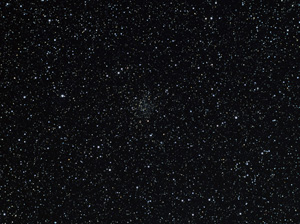 NGC 2141 This is a 108 minute exposure (27x240) of cluster NGC 2141 in Orion, taken 20 Feb 2012. The image is at full scale resolution of the camera but is cropped sligtly. The camera was an Orion StarShoot Pro Deep Space CCD Color Imager (version 1), an Astro-Tech field flattener was also in the optical path. Telescope was a Vixen 102ED (102mm F6.5 refractor). Guiding was via an Orion autoguider through Celestron C-14. Click on the small mage and the full size image will open in a new window.
NGC 2141 This is a 108 minute exposure (27x240) of cluster NGC 2141 in Orion, taken 20 Feb 2012. The image is at full scale resolution of the camera but is cropped sligtly. The camera was an Orion StarShoot Pro Deep Space CCD Color Imager (version 1), an Astro-Tech field flattener was also in the optical path. Telescope was a Vixen 102ED (102mm F6.5 refractor). Guiding was via an Orion autoguider through Celestron C-14. Click on the small mage and the full size image will open in a new window.
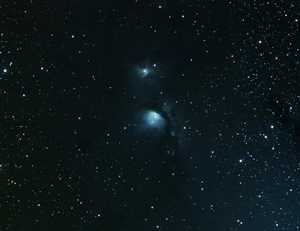 M78 This is a 100 minute exposure (25x240) of reflection nebula M78 in Orion, taken 17 Feb 2012. The image is reduced from full scale resolution of the camera and is cropped sligtly. The camera was an Orion StarShoot Pro Deep Space CCD Color Imager (version 1), an Astro-Tech field flattener was also in the optical path. Telescope was a Vixen 102ED (102mm F6.5 refractor). Guiding was via an Orion autoguider through Celestron C-14. Click on the small mage and the full size image will open in a new window.
M78 This is a 100 minute exposure (25x240) of reflection nebula M78 in Orion, taken 17 Feb 2012. The image is reduced from full scale resolution of the camera and is cropped sligtly. The camera was an Orion StarShoot Pro Deep Space CCD Color Imager (version 1), an Astro-Tech field flattener was also in the optical path. Telescope was a Vixen 102ED (102mm F6.5 refractor). Guiding was via an Orion autoguider through Celestron C-14. Click on the small mage and the full size image will open in a new window.
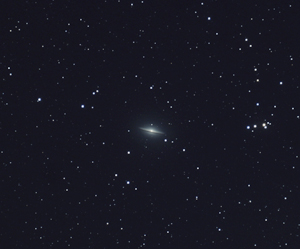 M104 This is a 132 minute exposure (33x240) of the so-called "Sombrero" galaxy, taken 17 Feb 2012. The image is reduced from full scale resolution of the camera and is cropped sligtly. The camera was an Orion StarShoot Pro Deep Space CCD Color Imager (version 1), an Astro-Tech field flattener was also in the optical path. Telescope was a Vixen 102ED (102mm F6.5 refractor). Guiding was via an Orion autoguider through Celestron C-14. Click on the small mage and the full size image will open in a new window.
M104 This is a 132 minute exposure (33x240) of the so-called "Sombrero" galaxy, taken 17 Feb 2012. The image is reduced from full scale resolution of the camera and is cropped sligtly. The camera was an Orion StarShoot Pro Deep Space CCD Color Imager (version 1), an Astro-Tech field flattener was also in the optical path. Telescope was a Vixen 102ED (102mm F6.5 refractor). Guiding was via an Orion autoguider through Celestron C-14. Click on the small mage and the full size image will open in a new window.
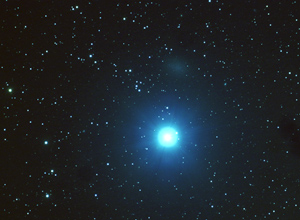 Leo 1 This is a 172 minute exposure (43x240) of the galaxy Leo 1 (in Leo), taken 17 Feb 2012. The incredibly bright star in the image is Regulus (fantastically overexposed in this nearly 3 hour exposure). This galaxy is difficult to see (and image) due to Regulus being so close to it. Numerous other faitn galaxies are also visible upon close inspection. The image is at the full scale resolution of the camera and is cropped sligtly. The camera was an Orion StarShoot Pro Deep Space CCD Color Imager (version 1), an Astro-Tech field flattener was also in the optical path. Telescope was a Vixen 102ED (102mm F6.5 refractor). Guiding was via an Orion autoguider through Celestron C-14. Click on the small mage and the full size image will open in a new window.
Leo 1 This is a 172 minute exposure (43x240) of the galaxy Leo 1 (in Leo), taken 17 Feb 2012. The incredibly bright star in the image is Regulus (fantastically overexposed in this nearly 3 hour exposure). This galaxy is difficult to see (and image) due to Regulus being so close to it. Numerous other faitn galaxies are also visible upon close inspection. The image is at the full scale resolution of the camera and is cropped sligtly. The camera was an Orion StarShoot Pro Deep Space CCD Color Imager (version 1), an Astro-Tech field flattener was also in the optical path. Telescope was a Vixen 102ED (102mm F6.5 refractor). Guiding was via an Orion autoguider through Celestron C-14. Click on the small mage and the full size image will open in a new window.
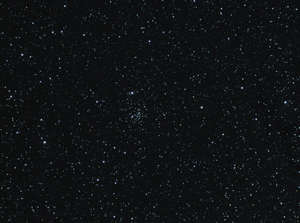 NGC 2355 This is a 56 minute exposure (17x240) of the cluster NGC 2355 in Gemini, taken 17 Feb 2012. The image is at the full scale resolution of the camera and is cropped sligtly. The camera was an Orion StarShoot Pro Deep Space CCD Color Imager (version 1), an Astro-Tech field flattener was also in the optical path. Telescope was a Vixen 102ED (102mm F6.5 refractor). Guiding was via an Orion autoguider through Celestron C-14. Click on the small mage and the full size image will open in a new window.
NGC 2355 This is a 56 minute exposure (17x240) of the cluster NGC 2355 in Gemini, taken 17 Feb 2012. The image is at the full scale resolution of the camera and is cropped sligtly. The camera was an Orion StarShoot Pro Deep Space CCD Color Imager (version 1), an Astro-Tech field flattener was also in the optical path. Telescope was a Vixen 102ED (102mm F6.5 refractor). Guiding was via an Orion autoguider through Celestron C-14. Click on the small mage and the full size image will open in a new window.
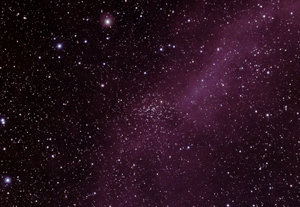 NGC 2112 This is a 176 minute exposure (44x240) of the cluster NGC 2112 in Orion, taken 13 Feb 2012. The nebula is part of Barnard's Loop... when I was taking this image I was initially cursing "clouds" however the cloud was actually part of the loop! The image is reduced from full scale resolution of the camera and is cropped sligtly. The camera was an Orion StarShoot Pro Deep Space CCD Color Imager (version 1), an Astro-Tech field flattener was also in the optical path. Telescope was a Vixen 102ED (102mm F6.5 refractor). Guiding was via an Orion autoguider through Celestron C-14. Click on the small image and the full size image will open in a new window.
NGC 2112 This is a 176 minute exposure (44x240) of the cluster NGC 2112 in Orion, taken 13 Feb 2012. The nebula is part of Barnard's Loop... when I was taking this image I was initially cursing "clouds" however the cloud was actually part of the loop! The image is reduced from full scale resolution of the camera and is cropped sligtly. The camera was an Orion StarShoot Pro Deep Space CCD Color Imager (version 1), an Astro-Tech field flattener was also in the optical path. Telescope was a Vixen 102ED (102mm F6.5 refractor). Guiding was via an Orion autoguider through Celestron C-14. Click on the small image and the full size image will open in a new window.
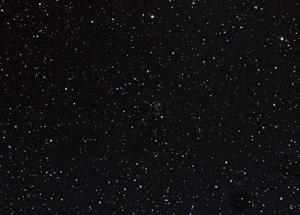 NGC 1883 This is a 20 minute exposure (5x240) of the cluster NGC 1883 in Auriga, taken 3 Feb 2012. Unfortunately clouds came in an ruined imaging for the evening when I was working this cluster so I was only able to obtain 5 useful data frames on it. The image needs more exposure but it is the best one I have for now. The image is reduced from full scale resolution of the camera and is cropped sligtly. The camera was an Orion StarShoot Pro Deep Space CCD Color Imager (version 1), an Astro-Tech field flattener was also in the optical path. Telescope was a Vixen 102ED (102mm F6.5 refractor). Guiding was via an Orion autoguider through Celestron C-14. Click on the small mage and the full size image will open in a new window.
NGC 1883 This is a 20 minute exposure (5x240) of the cluster NGC 1883 in Auriga, taken 3 Feb 2012. Unfortunately clouds came in an ruined imaging for the evening when I was working this cluster so I was only able to obtain 5 useful data frames on it. The image needs more exposure but it is the best one I have for now. The image is reduced from full scale resolution of the camera and is cropped sligtly. The camera was an Orion StarShoot Pro Deep Space CCD Color Imager (version 1), an Astro-Tech field flattener was also in the optical path. Telescope was a Vixen 102ED (102mm F6.5 refractor). Guiding was via an Orion autoguider through Celestron C-14. Click on the small mage and the full size image will open in a new window.
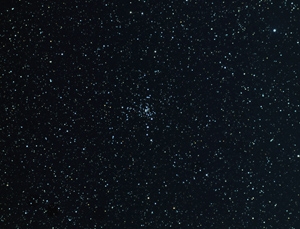 NGC 2301 This is a 28 minute exposure (7x240) of the cluster NGC 2301 in Monoceros, taken 1 Feb 2012. The image is rat full scale resolution of the camera and is cropped sligtly. The camera was an Orion StarShoot Pro Deep Space CCD Color Imager (version 1), an Astro-Tech field flattener was also in the optical path. Telescope was a Vixen 102ED (102mm F6.5 refractor). Guiding was via an Orion autoguider through Celestron C-14. Click on the small mage and the full size image will open in a new window.
NGC 2301 This is a 28 minute exposure (7x240) of the cluster NGC 2301 in Monoceros, taken 1 Feb 2012. The image is rat full scale resolution of the camera and is cropped sligtly. The camera was an Orion StarShoot Pro Deep Space CCD Color Imager (version 1), an Astro-Tech field flattener was also in the optical path. Telescope was a Vixen 102ED (102mm F6.5 refractor). Guiding was via an Orion autoguider through Celestron C-14. Click on the small mage and the full size image will open in a new window.
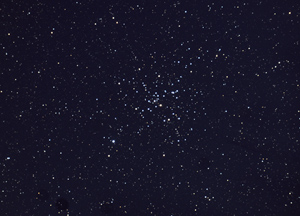 M41 This is a 40 minute exposure (10x240) of the cluster M41 in Canis Major, taken 1 Feb 2012. Guiding was somewhat off on this image but for the moment it is the best image I have of M41. I only have a fairly short window to get objects at this lower latitude due to trees in the south. The image is reduced from full scale resolution of the camera and is cropped sligtly. The camera was an Orion StarShoot Pro Deep Space CCD Color Imager (version 1), an Astro-Tech field flattener was also in the optical path. Telescope was a Vixen 102ED (102mm F6.5 refractor). Guiding was via an Orion autoguider through Celestron C-14. Click on the small mage and the full size image will open in a new window.
M41 This is a 40 minute exposure (10x240) of the cluster M41 in Canis Major, taken 1 Feb 2012. Guiding was somewhat off on this image but for the moment it is the best image I have of M41. I only have a fairly short window to get objects at this lower latitude due to trees in the south. The image is reduced from full scale resolution of the camera and is cropped sligtly. The camera was an Orion StarShoot Pro Deep Space CCD Color Imager (version 1), an Astro-Tech field flattener was also in the optical path. Telescope was a Vixen 102ED (102mm F6.5 refractor). Guiding was via an Orion autoguider through Celestron C-14. Click on the small mage and the full size image will open in a new window.
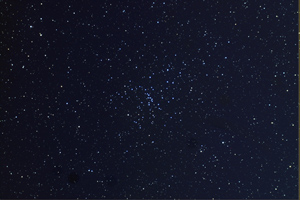 M48 This is a 120 minute exposure (30x240) of the cluster M48 in Hydra, taken 1 Feb 2012. There are some flat field artifacts in this image however it is the best one I have for the moment. The image is reduced from full scale resolution of the camera and is cropped sligtly. The camera was an Orion StarShoot Pro Deep Space CCD Color Imager (version 1), an Astro-Tech field flattener was also in the optical path. Telescope was a Vixen 102ED (102mm F6.5 refractor). Guiding was via an Orion autoguider through Celestron C-14. Click on the small mage and the full size image will open in a new window.
M48 This is a 120 minute exposure (30x240) of the cluster M48 in Hydra, taken 1 Feb 2012. There are some flat field artifacts in this image however it is the best one I have for the moment. The image is reduced from full scale resolution of the camera and is cropped sligtly. The camera was an Orion StarShoot Pro Deep Space CCD Color Imager (version 1), an Astro-Tech field flattener was also in the optical path. Telescope was a Vixen 102ED (102mm F6.5 refractor). Guiding was via an Orion autoguider through Celestron C-14. Click on the small mage and the full size image will open in a new window.
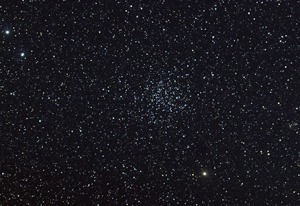 M46 and NGC 2438 This is a 92 minute exposure (23x240) of the cluster M46 in Puppis, also visible is planetary nebula NGC 2438. This image was taken 29 Jan 2012. The image is reduced from full scale resolution of the camera and is cropped sligtly. The camera was an Orion StarShoot Pro Deep Space CCD Color Imager (version 1), an Astro-Tech field flattener was also in the optical path. Telescope was a Vixen 102ED (102mm F6.5 refractor). Guiding was via an Orion autoguider through Celestron C-14. Click on the small mage and the full size image will open in a new window.
M46 and NGC 2438 This is a 92 minute exposure (23x240) of the cluster M46 in Puppis, also visible is planetary nebula NGC 2438. This image was taken 29 Jan 2012. The image is reduced from full scale resolution of the camera and is cropped sligtly. The camera was an Orion StarShoot Pro Deep Space CCD Color Imager (version 1), an Astro-Tech field flattener was also in the optical path. Telescope was a Vixen 102ED (102mm F6.5 refractor). Guiding was via an Orion autoguider through Celestron C-14. Click on the small mage and the full size image will open in a new window.
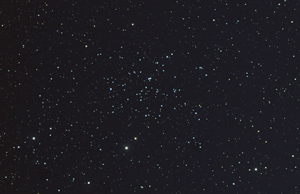 NGC 1647 This is an 88 minute exposure (22x240) of the cluster NGC 1647 in Taurus, taken 29 Januar 2012. The image is cropped somewhat. The camera was an Orion StarShoot Pro Deep Space CCD Color Imager (version 1), an Astro-Tech field flattener was also in the optical path. Telescope was a Vixen 102ED (102mm F6.5 refractor). Guiding was via an Orion autoguider through Celestron C-14. Click on the small mage and the full size image will open in a new window. The full resolution image is available here .
NGC 1647 This is an 88 minute exposure (22x240) of the cluster NGC 1647 in Taurus, taken 29 Januar 2012. The image is cropped somewhat. The camera was an Orion StarShoot Pro Deep Space CCD Color Imager (version 1), an Astro-Tech field flattener was also in the optical path. Telescope was a Vixen 102ED (102mm F6.5 refractor). Guiding was via an Orion autoguider through Celestron C-14. Click on the small mage and the full size image will open in a new window. The full resolution image is available here .
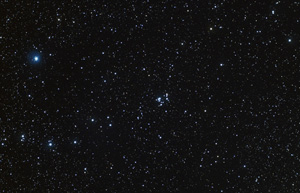 NGC 2169 This is an 80 minute exposure (22x240) of the cluster NGC 2169 in Orion, taken 29 January 2012. The image is cropped somewhat. The camera was an Orion StarShoot Pro Deep Space CCD Color Imager (version 1), an Astro-Tech field flattener was also in the optical path. Telescope was a Vixen 102ED (102mm F6.5 refractor). Guiding was via an Orion autoguider through Celestron C-14. Click on the small mage and the full size image will open in a new window. The full resolution image is available here .
NGC 2169 This is an 80 minute exposure (22x240) of the cluster NGC 2169 in Orion, taken 29 January 2012. The image is cropped somewhat. The camera was an Orion StarShoot Pro Deep Space CCD Color Imager (version 1), an Astro-Tech field flattener was also in the optical path. Telescope was a Vixen 102ED (102mm F6.5 refractor). Guiding was via an Orion autoguider through Celestron C-14. Click on the small mage and the full size image will open in a new window. The full resolution image is available here .
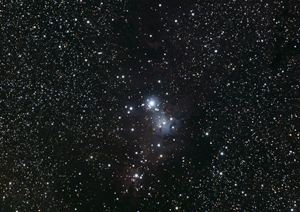 NGC 2264 This is a 52 minute exposure (13x240) of the Christmas Tree Cluster in Monoceros, taken 23 January 2012. The camera was an Orion StarShoot Pro Deep Space CCD Color Imager (version 1), an Astro-Tech field flattener was also in the optical path. Telescope was a Vixen 102ED (102mm F6.5 refractor). Guiding was via an Orion autoguider through Celestron C-14. Click on the small mage and the full size image will open in a new window.
NGC 2264 This is a 52 minute exposure (13x240) of the Christmas Tree Cluster in Monoceros, taken 23 January 2012. The camera was an Orion StarShoot Pro Deep Space CCD Color Imager (version 1), an Astro-Tech field flattener was also in the optical path. Telescope was a Vixen 102ED (102mm F6.5 refractor). Guiding was via an Orion autoguider through Celestron C-14. Click on the small mage and the full size image will open in a new window.
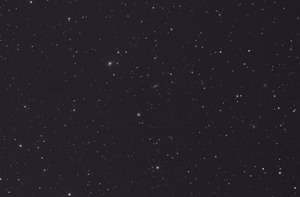 NGC 3972 and Neighbors This is a 180 minute exposure (45x240) of the NGC 3972 region in Ursa Major, taken 23 January 2012. NGC 3972 is the elongated galaxy in the image. It forms a right triangle with 2 other bright galaxies, NGC3998 is the bright round one to the upper left and NGC 3982 is the bright (but small and tight) spiral galaxy to the lower left. A plethora of other faint galaxies are visible in this image, the faintest ones are around magnitude 17.5. In the lower right area of this image is a galaxy that at first looks like a comet, this is NGC 3921. This image is at the full resolution of the camera and is cropped slightly. The camera was an Orion StarShoot Pro Deep Space CCD Color Imager (version 1), an Astro-Tech field flattener was also in the optical path. Telescope was a Vixen 102ED (102mm F6.5 refractor). Guiding was via an Orion autoguider through Celestron C-14. Click on the small mage and the full size image will open in a new window.
NGC 3972 and Neighbors This is a 180 minute exposure (45x240) of the NGC 3972 region in Ursa Major, taken 23 January 2012. NGC 3972 is the elongated galaxy in the image. It forms a right triangle with 2 other bright galaxies, NGC3998 is the bright round one to the upper left and NGC 3982 is the bright (but small and tight) spiral galaxy to the lower left. A plethora of other faint galaxies are visible in this image, the faintest ones are around magnitude 17.5. In the lower right area of this image is a galaxy that at first looks like a comet, this is NGC 3921. This image is at the full resolution of the camera and is cropped slightly. The camera was an Orion StarShoot Pro Deep Space CCD Color Imager (version 1), an Astro-Tech field flattener was also in the optical path. Telescope was a Vixen 102ED (102mm F6.5 refractor). Guiding was via an Orion autoguider through Celestron C-14. Click on the small mage and the full size image will open in a new window.
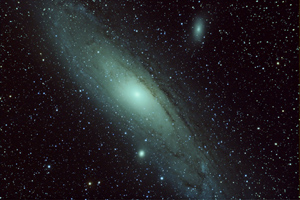 M31 This is a 92 minute exposure (23x240) of the M31 in Andromeda, taken 09 October 2010. The data from this image was reprocessed in January 2013 for a much better result. I did not have the field flattener in 2010, so this image does exhibit some anomalies out towards the edges; to minimize these artifacts I reduced the image size to 1920 pixels wide. The camera was an Orion StarShoot Pro Deep Space CCD Color Imager (version 1), the telescope was a Vixen 102ED (102mm F6.5 refractor). Guiding was via an Orion autoguider through Celestron C-14. Click on the small mage and the full size image will open in a new window.
M31 This is a 92 minute exposure (23x240) of the M31 in Andromeda, taken 09 October 2010. The data from this image was reprocessed in January 2013 for a much better result. I did not have the field flattener in 2010, so this image does exhibit some anomalies out towards the edges; to minimize these artifacts I reduced the image size to 1920 pixels wide. The camera was an Orion StarShoot Pro Deep Space CCD Color Imager (version 1), the telescope was a Vixen 102ED (102mm F6.5 refractor). Guiding was via an Orion autoguider through Celestron C-14. Click on the small mage and the full size image will open in a new window.
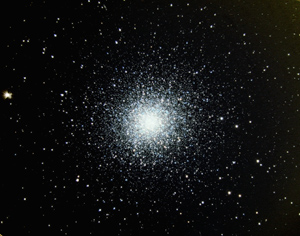 M13 This is a 84 minute exposure (21x240) of the M13 in Andromeda taken 31 May 2011. The raw data from this image was reprocessed in September 2012 for a much better result. This image is my best of M13 to date. It was taken with a Celestron 14 telescope (with an F3.3 reducer in line). The image is cropped considerably and reduced in size also to help reduce artifacts of the 3.3 reducer (those were made for when CCD chips were really small). The camera was an Orion StarShoot Pro Deep Space CCD Color Imager (version 1), guiding was via an Orion autoguider through a Vixen 102ED refractor. Click on the small mage and the full size image will open in a new window.
M13 This is a 84 minute exposure (21x240) of the M13 in Andromeda taken 31 May 2011. The raw data from this image was reprocessed in September 2012 for a much better result. This image is my best of M13 to date. It was taken with a Celestron 14 telescope (with an F3.3 reducer in line). The image is cropped considerably and reduced in size also to help reduce artifacts of the 3.3 reducer (those were made for when CCD chips were really small). The camera was an Orion StarShoot Pro Deep Space CCD Color Imager (version 1), guiding was via an Orion autoguider through a Vixen 102ED refractor. Click on the small mage and the full size image will open in a new window.
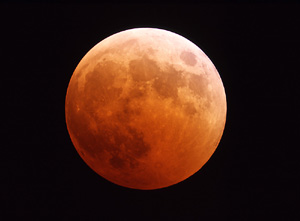 27 October 2004 Total Lunar Eclipse Photos taken using a digital camera through a Criterion RV-6 Dynascope 6" Newtonian reflector and also one slide image. Click on the small image and the full size image will open in a new window.
27 October 2004 Total Lunar Eclipse Photos taken using a digital camera through a Criterion RV-6 Dynascope 6" Newtonian reflector and also one slide image. Click on the small image and the full size image will open in a new window.
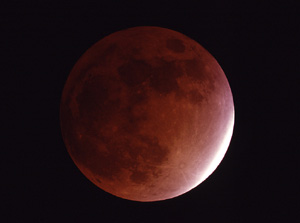 8 November 2003 Total Lunar Eclipse Photos taken using a digital camera through an Edmund Astroscan and also slide film pictures through a Celestron CG-11. Click on the small image and the full size image will open in a new window.
8 November 2003 Total Lunar Eclipse Photos taken using a digital camera through an Edmund Astroscan and also slide film pictures through a Celestron CG-11. Click on the small image and the full size image will open in a new window.
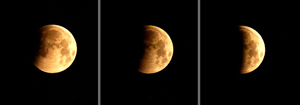 23 March 1997 partial Lunar Eclipse Photos taken through Tasco 2.4 inch scope, 3 shots. Click on the small image and the full size image will open in a new window.
23 March 1997 partial Lunar Eclipse Photos taken through Tasco 2.4 inch scope, 3 shots. Click on the small image and the full size image will open in a new window.
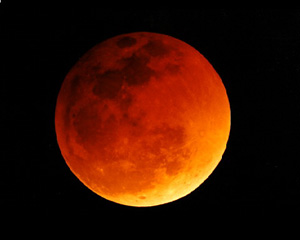 3 April 1996 Lunar Eclipse Sampler Total Lunar Eclipse at dusk (3 close ups and one scenic shot). Click on the small image and the full size image will open in a new window.
3 April 1996 Lunar Eclipse Sampler Total Lunar Eclipse at dusk (3 close ups and one scenic shot). Click on the small image and the full size image will open in a new window.
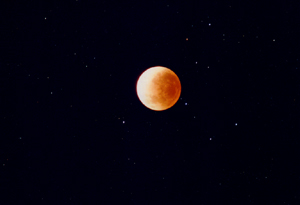 27-28 November 1993 Total Lunar Eclipse Sequence Sampler Six shots total, one wide angle and 5 close ups, showing the progress of the eclipse. Click on the small image and the full size image will open in a new window.
27-28 November 1993 Total Lunar Eclipse Sequence Sampler Six shots total, one wide angle and 5 close ups, showing the progress of the eclipse. Click on the small image and the full size image will open in a new window.
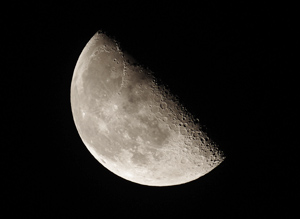 Waning Quarter Moon, 31 May 2013 This shot of the crescent Moon was taken with a Vixen 102ED (4") refractor using a Pentax K-x DSLR. 1/160 second, ISO 200. Click on the small image and the full size image will open in a new window.
Waning Quarter Moon, 31 May 2013 This shot of the crescent Moon was taken with a Vixen 102ED (4") refractor using a Pentax K-x DSLR. 1/160 second, ISO 200. Click on the small image and the full size image will open in a new window.
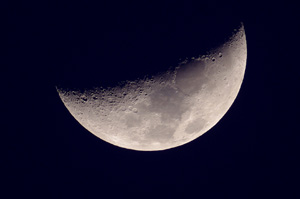 Waxing Crescent Moon, 16 May 2013 This shot of the crescent Moon was taken with a Vixen 102ED (4") refractor using a Pentax K-x DSLR. 1/200 second, ISO 200. Click on the small image and the full size image will open in a new window.
Waxing Crescent Moon, 16 May 2013 This shot of the crescent Moon was taken with a Vixen 102ED (4") refractor using a Pentax K-x DSLR. 1/200 second, ISO 200. Click on the small image and the full size image will open in a new window.
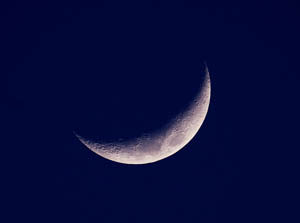 Waxing Crescent Moon, 14 May 2013 This shot of the crescent Moon was taken with a Vixen 102ED (4") refractor using a Pentax K-x DSLR. 1/200 second, ISO 200. The sky was still deep blue when this was taken. Click on the small image and the full size image will open in a new window.
Waxing Crescent Moon, 14 May 2013 This shot of the crescent Moon was taken with a Vixen 102ED (4") refractor using a Pentax K-x DSLR. 1/200 second, ISO 200. The sky was still deep blue when this was taken. Click on the small image and the full size image will open in a new window.
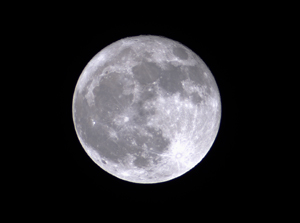 Full "Cold" Moon, 28 December 2012 Here's a shot of the full Cold Moon (sometimes called the "Long Nights" Moon) taken with a Pentax K-x DSLR. 1/250 second, ISO 400. The telescope was an Orion 90mm F10 refractor OTA. Click on the small image and the full size image will open in a new window.
Full "Cold" Moon, 28 December 2012 Here's a shot of the full Cold Moon (sometimes called the "Long Nights" Moon) taken with a Pentax K-x DSLR. 1/250 second, ISO 400. The telescope was an Orion 90mm F10 refractor OTA. Click on the small image and the full size image will open in a new window.
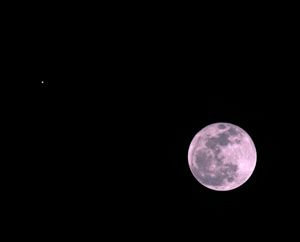 Moon and Jupiter, 28 November 2012 This is a shot of the Full Moon and Jupiter, taken on 28 November 2012. It is a large format image (you will need to scroll around to see everything). Jupiter reveals several cloud bands as well as 3 Moons. Taken with a Pentax DSLR and a 4" refractor. Click on the small image and the full size image will open in a new window.
Moon and Jupiter, 28 November 2012 This is a shot of the Full Moon and Jupiter, taken on 28 November 2012. It is a large format image (you will need to scroll around to see everything). Jupiter reveals several cloud bands as well as 3 Moons. Taken with a Pentax DSLR and a 4" refractor. Click on the small image and the full size image will open in a new window.
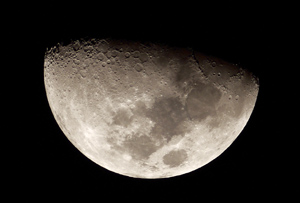 Moon, 23 September 2012 Taken with a Pentax K-x DSLR through a 4" refractor. Click on the small image and the full size image will open in a new window.
Moon, 23 September 2012 Taken with a Pentax K-x DSLR through a 4" refractor. Click on the small image and the full size image will open in a new window.
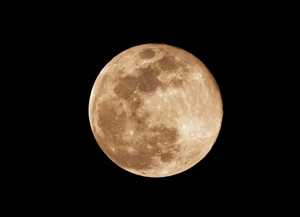 Blue Moon, 31 August 2012 The Blue Moon of 31 Aug 2012, taken with a Pentax K-x DSLR through a 4" refractor. Click on the small image and the full size image will open in a new window.
Blue Moon, 31 August 2012 The Blue Moon of 31 Aug 2012, taken with a Pentax K-x DSLR through a 4" refractor. Click on the small image and the full size image will open in a new window.
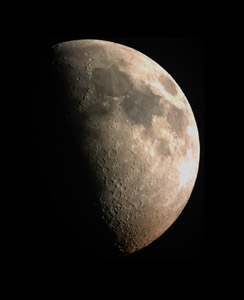 First Quarter Moon, 4 Jan 2009 Here's a shot of the First Quarter Moon taken on 4 January 2009. This shot was taken using a very modest telescope... a 3" Newtonian Reflector! The scope was the Orion Spaceprobe 3 Alt-Az although for this shot I mounted the Orion scope on my Losmandy G-11 mount. This shot was taken with the Orion StarShoot Solar System Color Imager II. This is a stack of two exposures. This image shows that even an entry level scope is capable of some nice astrophotography on the Moon. Click on the small image and the full size image will open in a new window.
First Quarter Moon, 4 Jan 2009 Here's a shot of the First Quarter Moon taken on 4 January 2009. This shot was taken using a very modest telescope... a 3" Newtonian Reflector! The scope was the Orion Spaceprobe 3 Alt-Az although for this shot I mounted the Orion scope on my Losmandy G-11 mount. This shot was taken with the Orion StarShoot Solar System Color Imager II. This is a stack of two exposures. This image shows that even an entry level scope is capable of some nice astrophotography on the Moon. Click on the small image and the full size image will open in a new window.
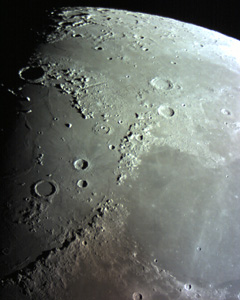 Northern area of Moon, 14 February 2008 This shot is a single exposure of the northern terminator area of the Moon at little past First Quarter phase. The camera used was the Orion StarShoot Solar System Color Imager II. Telescope was a Celestron C14 with a Meade F3.3 focal reducer. One of my best lunar close ups to date using the Orion imager. Click on the small image and the full size image will open in a new window.
Northern area of Moon, 14 February 2008 This shot is a single exposure of the northern terminator area of the Moon at little past First Quarter phase. The camera used was the Orion StarShoot Solar System Color Imager II. Telescope was a Celestron C14 with a Meade F3.3 focal reducer. One of my best lunar close ups to date using the Orion imager. Click on the small image and the full size image will open in a new window.
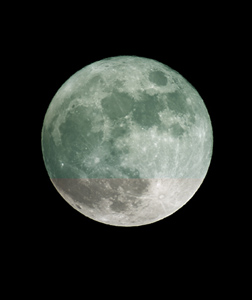 Full Moon, 21 March 2008 This is a two shot composite taken with the Orion StarShoot Solar System Color Imager II. Telescope was a Vixen 102ED refractor (102mm). Seeing was horrible tonight but I am satisfied with the image I got. Click on the small image and the full size image will open in a new window.
Full Moon, 21 March 2008 This is a two shot composite taken with the Orion StarShoot Solar System Color Imager II. Telescope was a Vixen 102ED refractor (102mm). Seeing was horrible tonight but I am satisfied with the image I got. Click on the small image and the full size image will open in a new window.
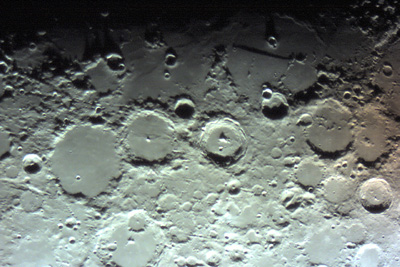 Central Terminator area of the Moon, 14 February 2008 This shot is a composite of two shots (they are not stacked, just stiched) of the Moon at little past First Quarter phase. The camera used was the Orion StarShoot Solar System Color Imager II. Telescope was a Celestron C14 with a Meade F3.3 focal reducer. One of my best lunar close ups to date using the Orion imager. Click on the small image and the full size image will open in a new window.
Central Terminator area of the Moon, 14 February 2008 This shot is a composite of two shots (they are not stacked, just stiched) of the Moon at little past First Quarter phase. The camera used was the Orion StarShoot Solar System Color Imager II. Telescope was a Celestron C14 with a Meade F3.3 focal reducer. One of my best lunar close ups to date using the Orion imager. Click on the small image and the full size image will open in a new window.
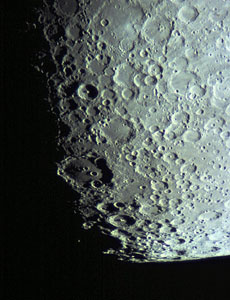 Southern area of the Moon, 16 January 2008 This shot is a single exposure of the southern terminator area of the Moon at little past First Quarter phase. The camera used was the Orion StarShoot Solar System Color Imager II. Telescope was the Vixen 102ED Refractor (a Daiken 2.4x barlow was used to increase the image scale). Click on the small image and the full size image will open in a new window.
Southern area of the Moon, 16 January 2008 This shot is a single exposure of the southern terminator area of the Moon at little past First Quarter phase. The camera used was the Orion StarShoot Solar System Color Imager II. Telescope was the Vixen 102ED Refractor (a Daiken 2.4x barlow was used to increase the image scale). Click on the small image and the full size image will open in a new window.
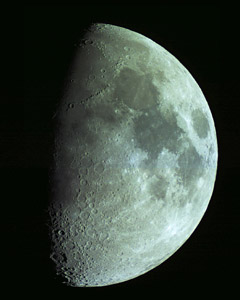 Moon, 16 January 2008 Here's a 2 shot mosiac f the Moon a little past First Quarter. The camera used was the Orion StarShoot Solar System Color Imager II. I took dozens of images and then picked the best 2 and assembled this mosiac in Photoshop. Telescope was the Vixen 102ED Refractor (straigh through shot, no barlow). Click on the small image and the full size image will open in a new window.
Moon, 16 January 2008 Here's a 2 shot mosiac f the Moon a little past First Quarter. The camera used was the Orion StarShoot Solar System Color Imager II. I took dozens of images and then picked the best 2 and assembled this mosiac in Photoshop. Telescope was the Vixen 102ED Refractor (straigh through shot, no barlow). Click on the small image and the full size image will open in a new window.
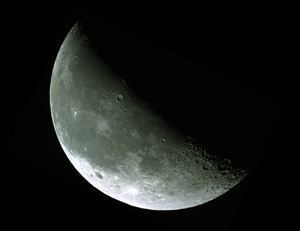 Waning Moon, 26 July 2008 The Moon from 26 July 2008, taken through a 4" reftactor. Click on the small image and the full size image will open in a new window.
Waning Moon, 26 July 2008 The Moon from 26 July 2008, taken through a 4" reftactor. Click on the small image and the full size image will open in a new window.
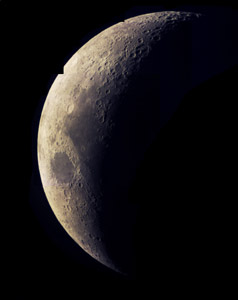 Moon Mosiac This is my first Moon mosiac, taken with a Vixen 102 ED Refractor (with a Daikin 2.4X barlow in line) on 21 April 2007. The camera used was the Orion StarShoot Solar System Color Imager II (picked this unit up recently). I took probably over 100 individual images and then selected the best ones and assembled them. In my carelessness I left out one small portion of the edge of the Moon, rather than "fake" the data in I left it as is. I was fairly happy with this first attempt at a lunar mosiac. Detail is overall very nice considering the scope is a modest 4" diameter! Click on the small image and the full size image will open in a new window.
Moon Mosiac This is my first Moon mosiac, taken with a Vixen 102 ED Refractor (with a Daikin 2.4X barlow in line) on 21 April 2007. The camera used was the Orion StarShoot Solar System Color Imager II (picked this unit up recently). I took probably over 100 individual images and then selected the best ones and assembled them. In my carelessness I left out one small portion of the edge of the Moon, rather than "fake" the data in I left it as is. I was fairly happy with this first attempt at a lunar mosiac. Detail is overall very nice considering the scope is a modest 4" diameter! Click on the small image and the full size image will open in a new window.
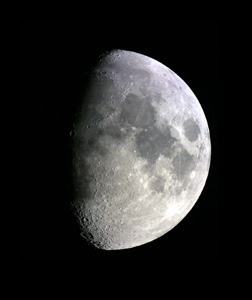 Moon, 25 May 2007 Here's a nice 2 shot mosiac of the Moon a little past First Quarter. The camera used was the Orion StarShoot Solar System Color Imager II. I took dozens of images and then picked the best 2 and assembled this mosiac in Photoshop. Telescope was the Vixen 102ED Refractor (straigh through shot, no barlow). Click on the small image and the full size image will open in a new window.
Moon, 25 May 2007 Here's a nice 2 shot mosiac of the Moon a little past First Quarter. The camera used was the Orion StarShoot Solar System Color Imager II. I took dozens of images and then picked the best 2 and assembled this mosiac in Photoshop. Telescope was the Vixen 102ED Refractor (straigh through shot, no barlow). Click on the small image and the full size image will open in a new window.
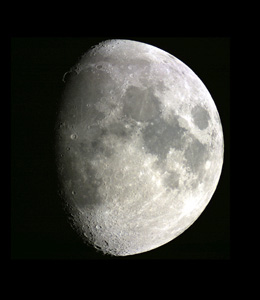 Moon, 26 May 2007 This shot is basically the same as above except it was taken one night later (amazing: 2 clear nights in a row!). Click on the small image and the full size image will open in a new window.
Moon, 26 May 2007 This shot is basically the same as above except it was taken one night later (amazing: 2 clear nights in a row!). Click on the small image and the full size image will open in a new window.
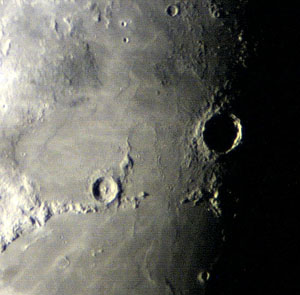 Copernicus The crater Copernicus at sunrise. Taken on 25 May 2007 using a Vixen 102 ED Refractor (with a Daikin 2.4X barlow in line) on 25 May 2007. The camera used was the Orion StarShoot Solar System Color Imager II. Click on the small image and the full size image will open in a new window.
Copernicus The crater Copernicus at sunrise. Taken on 25 May 2007 using a Vixen 102 ED Refractor (with a Daikin 2.4X barlow in line) on 25 May 2007. The camera used was the Orion StarShoot Solar System Color Imager II. Click on the small image and the full size image will open in a new window.
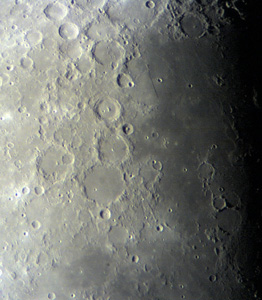 Straight Wall on the Moon The feature called the "Straight Wall" on the Moon (just to the right of upper center in the image) a little after sunrise. Taken on 25 May 2007 using a Vixen 102 ED Refractor (with a Daikin 2.4X barlow in line) on 25 May 2007. The camera used was the Orion StarShoot Solar System Color Imager II. Click on the small image and the full size image will open in a new window.
Straight Wall on the Moon The feature called the "Straight Wall" on the Moon (just to the right of upper center in the image) a little after sunrise. Taken on 25 May 2007 using a Vixen 102 ED Refractor (with a Daikin 2.4X barlow in line) on 25 May 2007. The camera used was the Orion StarShoot Solar System Color Imager II. Click on the small image and the full size image will open in a new window.
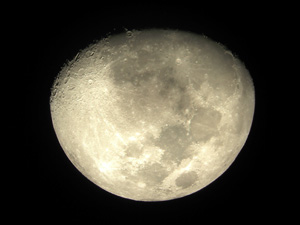 The Moon, 3 May 2001 This image of the Moon was taken with a 1999 vintage Olympus camera (C3030Z). This one was taken using a Televue 55mm Plossl eyepiece for projection Image from the camera was processed mildly using Adobe PhotoShop. Not that great of a shot by today's standards but not bad for the time. Click on the small image and the full size image will open in a new window.
The Moon, 3 May 2001 This image of the Moon was taken with a 1999 vintage Olympus camera (C3030Z). This one was taken using a Televue 55mm Plossl eyepiece for projection Image from the camera was processed mildly using Adobe PhotoShop. Not that great of a shot by today's standards but not bad for the time. Click on the small image and the full size image will open in a new window.
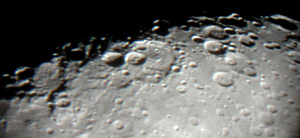 Lunar Shots from 2001 Some early digital camera photos (2) of the surface of the Moon as seen through the Celestron CG-11. Photos taken 12 January 2001. Click on the small image and the full size image will open in a new window.
Lunar Shots from 2001 Some early digital camera photos (2) of the surface of the Moon as seen through the Celestron CG-11. Photos taken 12 January 2001. Click on the small image and the full size image will open in a new window.
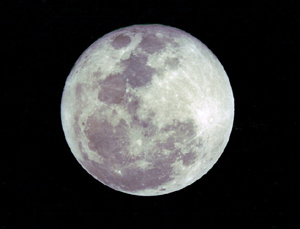 Full Moon of 22 December 1999 This is a photo of the super bright and super large full Moon of 22 December 1999. Taken with Celestron CG-11 operating at F6.3, 1/500 second exposure on Kodak Gold 100 film.Click on the small image and the full size image will open in a new window.
Full Moon of 22 December 1999 This is a photo of the super bright and super large full Moon of 22 December 1999. Taken with Celestron CG-11 operating at F6.3, 1/500 second exposure on Kodak Gold 100 film.Click on the small image and the full size image will open in a new window.
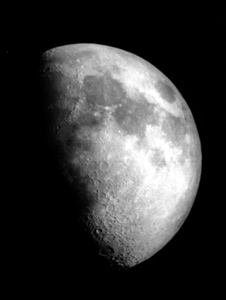 Two photos of the Moon taken with the Meade 4500 Newtonian reflector An older page of mine from 1998: A combination of film and digital processing yields some rather nice results [for the time] for such a small scope! 1 Aug 1998. Click on the small image and the full size image will open in a new window.
Two photos of the Moon taken with the Meade 4500 Newtonian reflector An older page of mine from 1998: A combination of film and digital processing yields some rather nice results [for the time] for such a small scope! 1 Aug 1998. Click on the small image and the full size image will open in a new window.
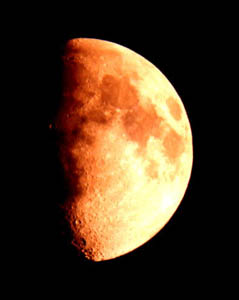 8 day old Moon An older shot, taken through a Meade 4.5 inch reflector with "camera up to eyepiece and snap" (afocal) method. Kodak Royal Gold 400 film, 10 October 1997. Click on the small image and the full size image will open in a new window.
8 day old Moon An older shot, taken through a Meade 4.5 inch reflector with "camera up to eyepiece and snap" (afocal) method. Kodak Royal Gold 400 film, 10 October 1997. Click on the small image and the full size image will open in a new window.
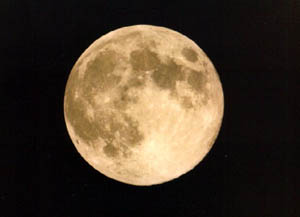 Full Moon from 1982 One of my earliest Moon shots, taken in 1982 with a Criterion Dynascope using a Pentax ME Super SLR film camera. Click on the small image and the full size image will open in a new window.
Full Moon from 1982 One of my earliest Moon shots, taken in 1982 with a Criterion Dynascope using a Pentax ME Super SLR film camera. Click on the small image and the full size image will open in a new window.
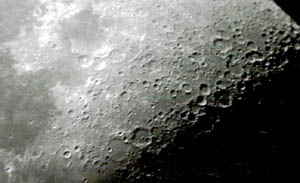 Southern area of Moon w/ Criterion 6" Dynascope Another of my earliest lunar shots. This was taken through a 6" Criterion Dynascope (6" F8 Newtonian) in early 1982. The camera was a Pentax ME Super, film was Tri-X. I developed it myself in the college darkroom. I remember showing this photo to a girl I liked... she said "You took this from Earth?" Click on the small image and the full size image will open in a new window.
Southern area of Moon w/ Criterion 6" Dynascope Another of my earliest lunar shots. This was taken through a 6" Criterion Dynascope (6" F8 Newtonian) in early 1982. The camera was a Pentax ME Super, film was Tri-X. I developed it myself in the college darkroom. I remember showing this photo to a girl I liked... she said "You took this from Earth?" Click on the small image and the full size image will open in a new window.
You can click here to download a photo sampler of Hale-Bopp, or select individual pictures from the list below. Pictures are in date order. Note for beginning astrophotographers: The photos below are the best from nearly four hundred shots of Hale Bopp that I took during its run! In other words, for every decent shot there are about eight to ten that fall into the "marginal", "so - so" or "dud" category.
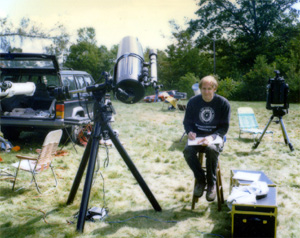 Me observing Jupiter in daylight at Connecticut Star Party IV, 04 Sep 1994. Click on the small image and the full size image will open in a new window.
Me observing Jupiter in daylight at Connecticut Star Party IV, 04 Sep 1994. Click on the small image and the full size image will open in a new window.
Use your browser's "back" button, or use links below if you arrived here via some other path:
This page is part of the site Amateur Astronomer's Notebook.
The Joe Roberts Home Page: www.RocketRoberts.com/joe.htm.
E-mail to Joe
Roberts
Images and HTML text © Copyright 2008 - 2011 by Joe Roberts. Please request permission to use
photos for purposes other than "personal use".